Last updated: 13th February 2022
We went for a long weekend of peace and tranquility in the Cotswolds. We’ve been before in winter, but not in the summer. Garth being a keen gardener especially wanted to see what those traditional English country gardens looked in full bloom and just how packed with flowers those hanging baskets really are! Armed with Garth’s Cotswolds itinerary and Phil’s sat-nav we set off to explore! In this post we’ll show you the best villages to explore and attractions of the Cotswolds.
Table of Contents
About The Cotswolds
The Cotswolds is an ‘AONB’ – one of England and Wales’s designated “Areas of Outstanding Natural Beauty”, so that tells you a lot. Cotswolds really is rural England at its finest, well known for its rolling hills, unspoilt scenery and superb examples of medieval towns and quintessential English villages. We discovered that the area flourished in the medieval period, becoming hugely wealthy for trading high quality wool. Affluent traders used the distinct honey coloured Cotswold Stone (which is Jurassic Limestone) to build marvellous homes and ‘wool churches’ which can still be seen and enjoyed today.
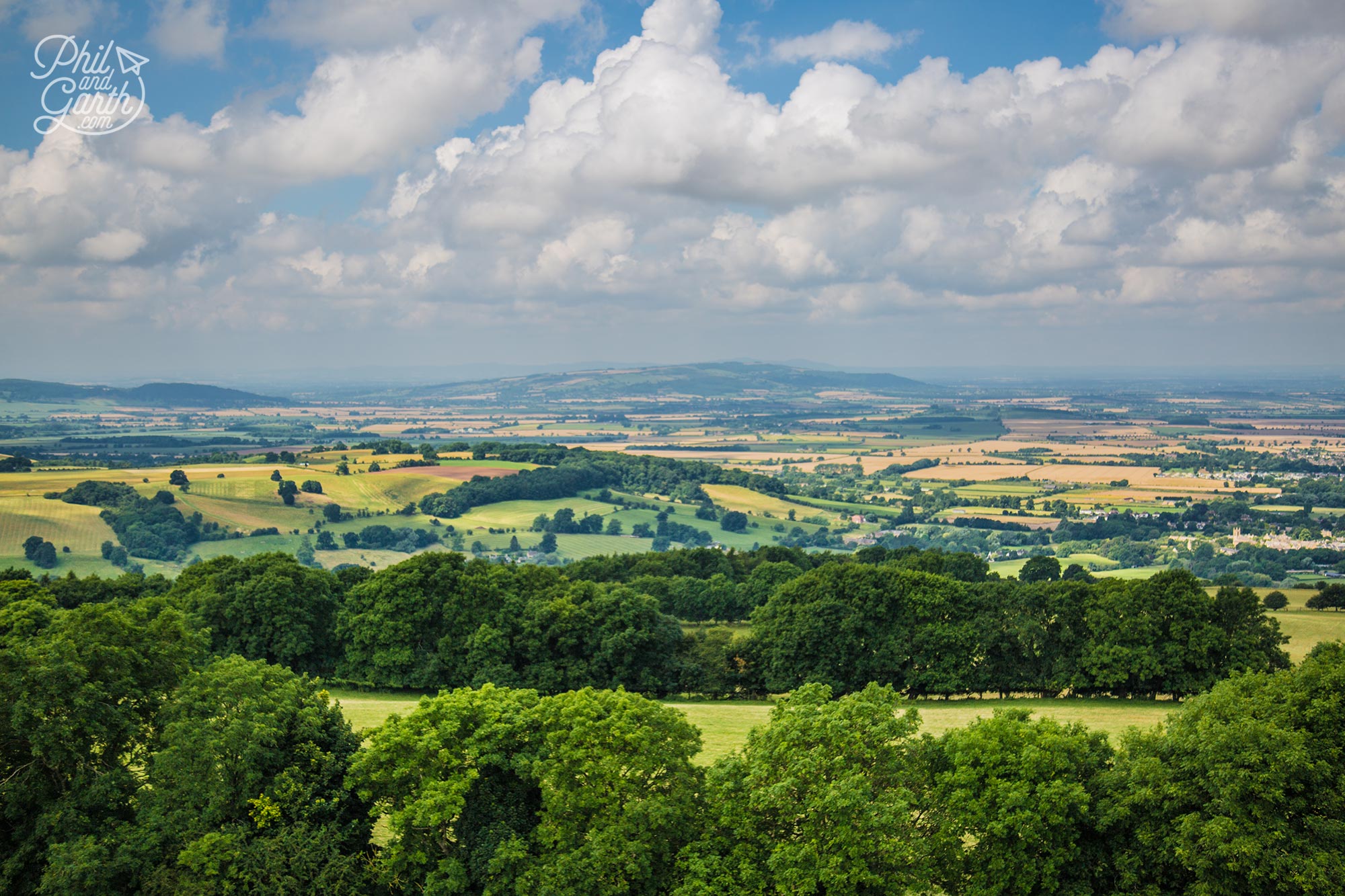
The rolling hills of the Cotswolds
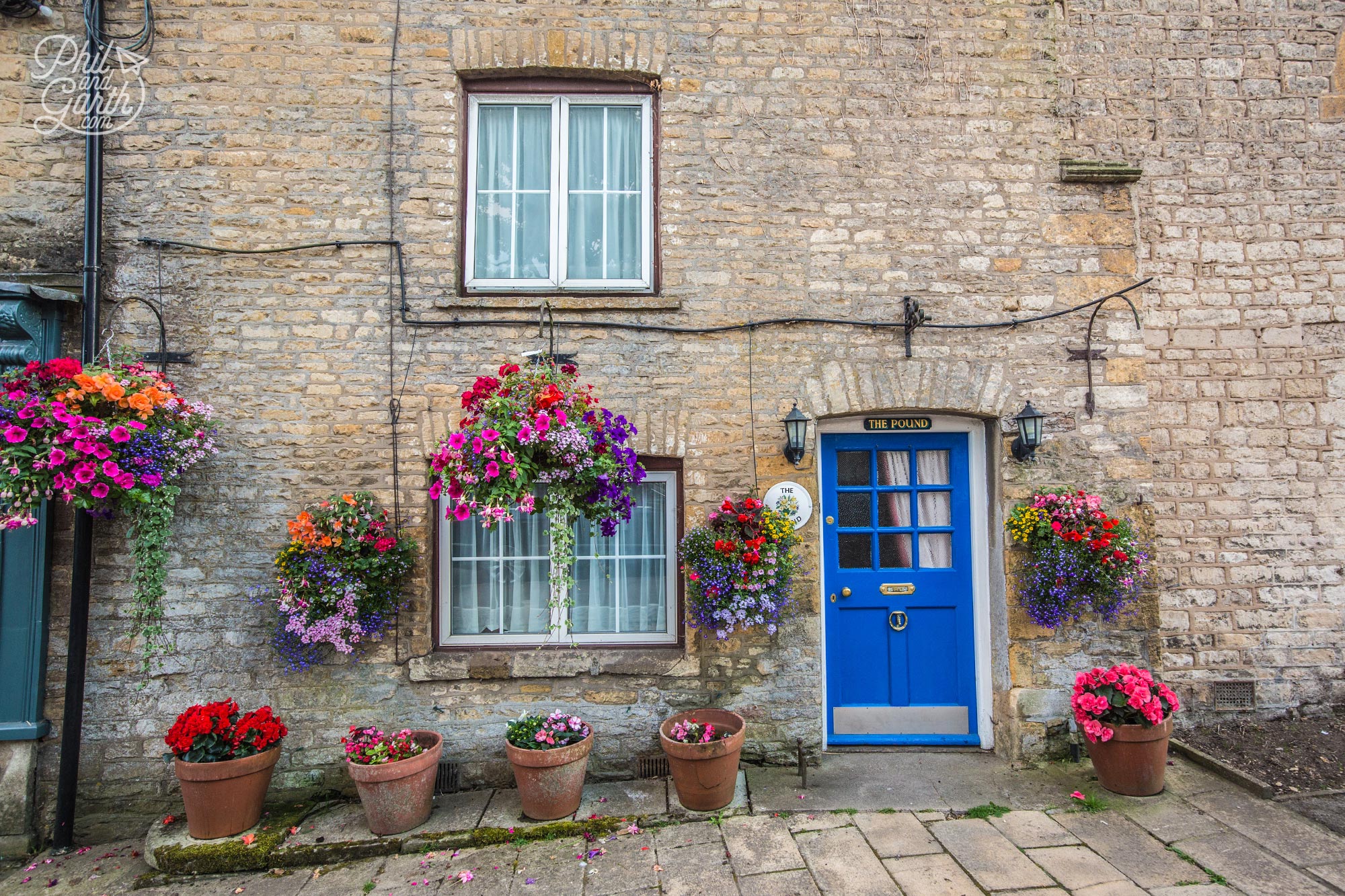
Colourful hanging baskets in Stow-on-the-Wold
Best Villages & Attractions Of The Cotswolds
Stow-on-the-Wold
We based ourself in Stow-on-the-Wold for a couple of nights, handy for the collection of villages and towns nearby. Stow-on-the-Wold is the highest town in the Cotswolds where seven major roads converge on the small town. It used to be the focus of the wool industry where massive annual trading fairs would take place, selling up to 20,000 sheep. Today it’s still a market town, and plays host to two annual Gypsy horse fairs. We were expecting it to be packed with tourists, but pleasantly surprised how quiet it was. We discovered plenty of ancient architecture – town houses containing arts and crafts shops, antique shops and cosy tea rooms.
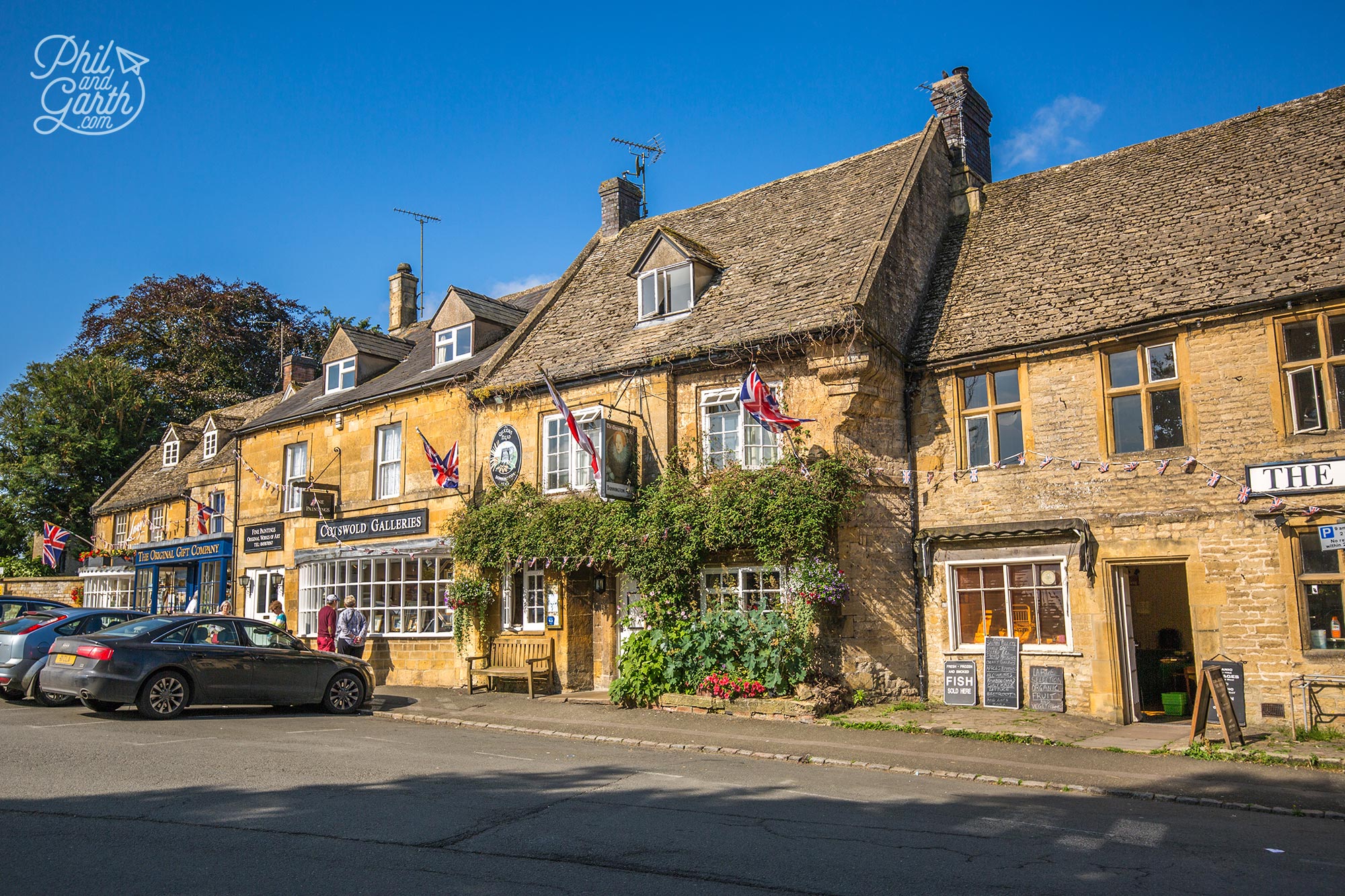
Stow-on-the-Wold tea and souvenir shops
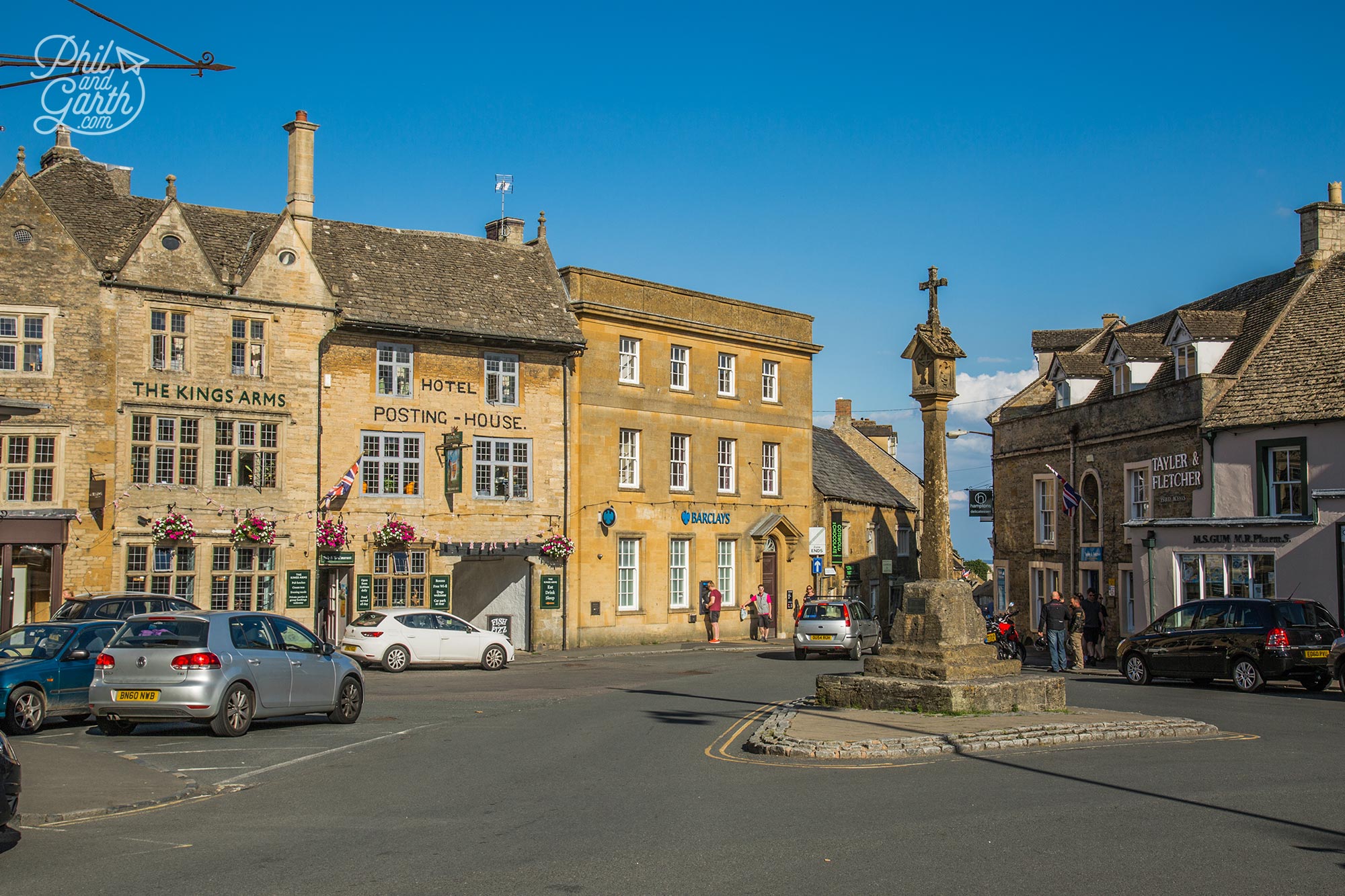
The ancient market cross at Stow-on-the-Wold
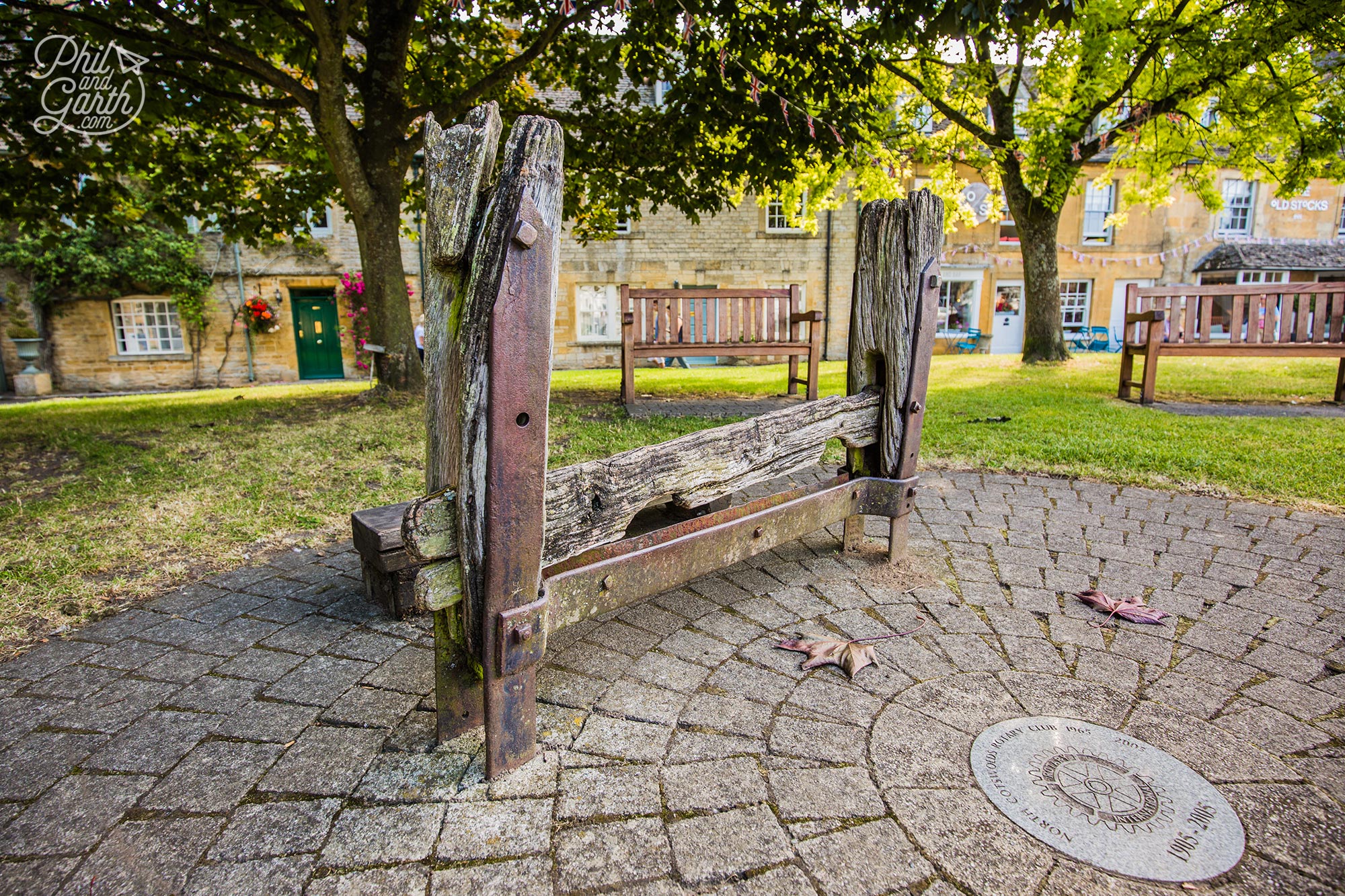
The village medieval stocks
We had a look at the ancient cross in the market square at one end of the town, which dates back to the Middle Ages. It was there to remind wool traders to trade fairly under the sight of God. At the other end are the town’s penal stocks, again medieval (what isn’t around here?!) this was where villagers would throw eggs, spit and humiliate criminals. It’s a good job we didn’t sit in….we could have been there some time!
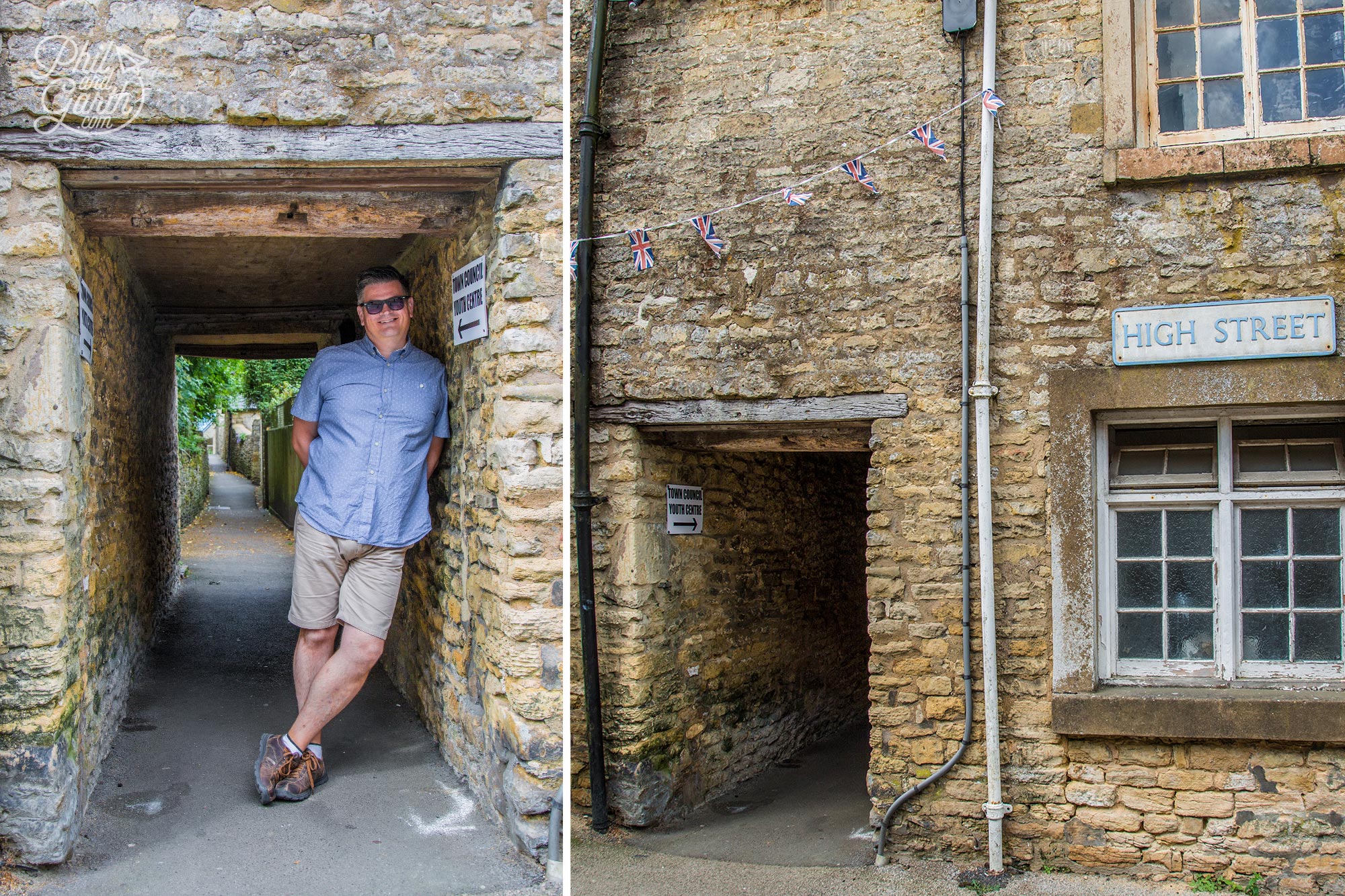
Phil inside a ‘ture’ an old alleyway
This alleyway is called a ‘ture’ – narrow streets between Stow’s buildings that connect to the market square, it’s where sheep were once hearded ready to be sold.
We went to a lovely old pub – The Porch House which dates back to 947AD. They claim to be England’s oldest pub, although so do several others in Britain! Including Ye Olde Fighting Cocks in St. Albans who fight over this title, so who knows?! Either way The Porch house been serving patrons for centuries, so we joined that long list. For Dinner we chose Cotswold Lamb and Dover Plaice followed by sticky toffee pudding! really tasty. We loved The Porch House’s cosy atmosphere, wooden beams and low ceilings and open fires.
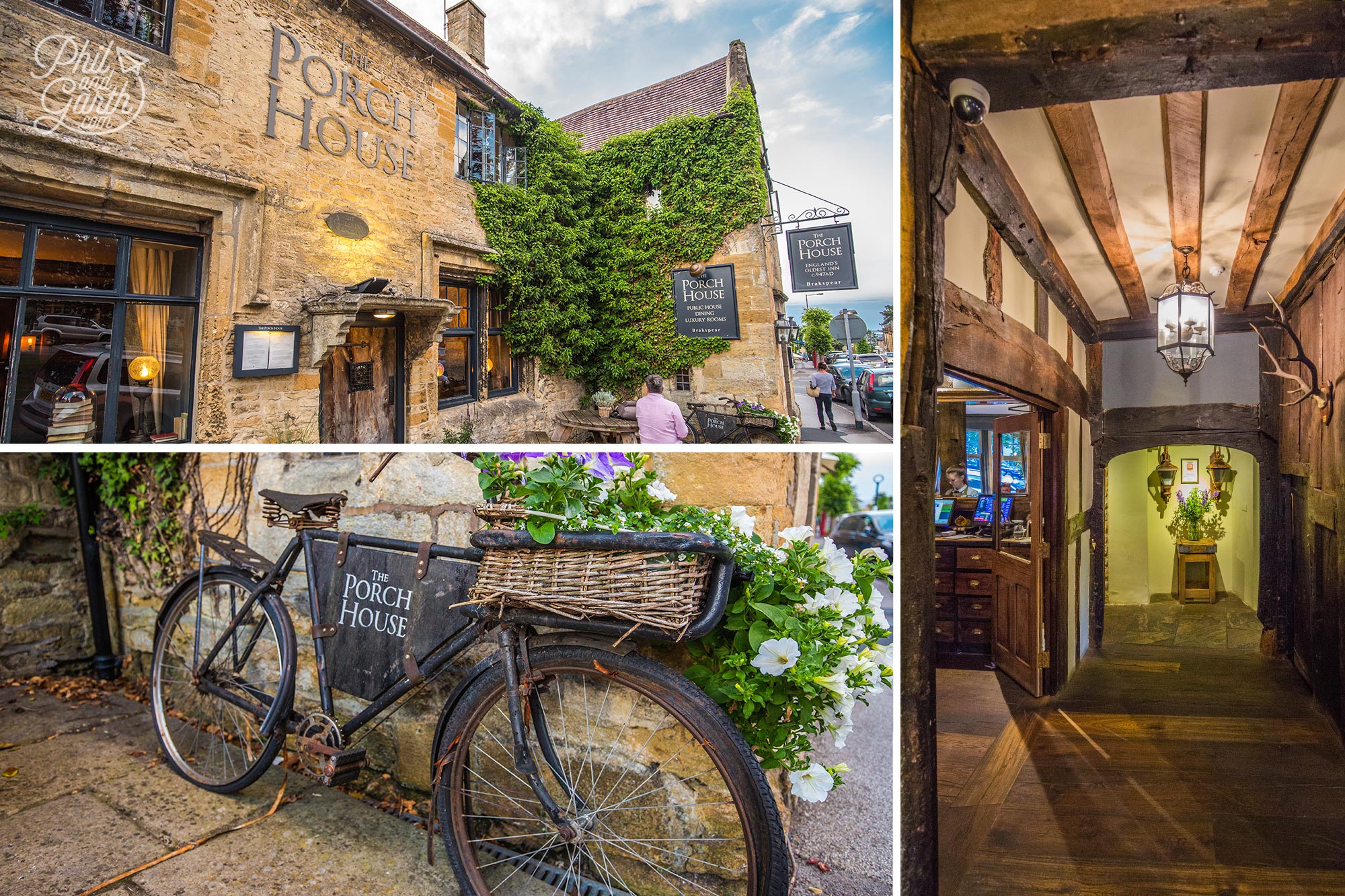
The Porch House – The oldest pub in Britain
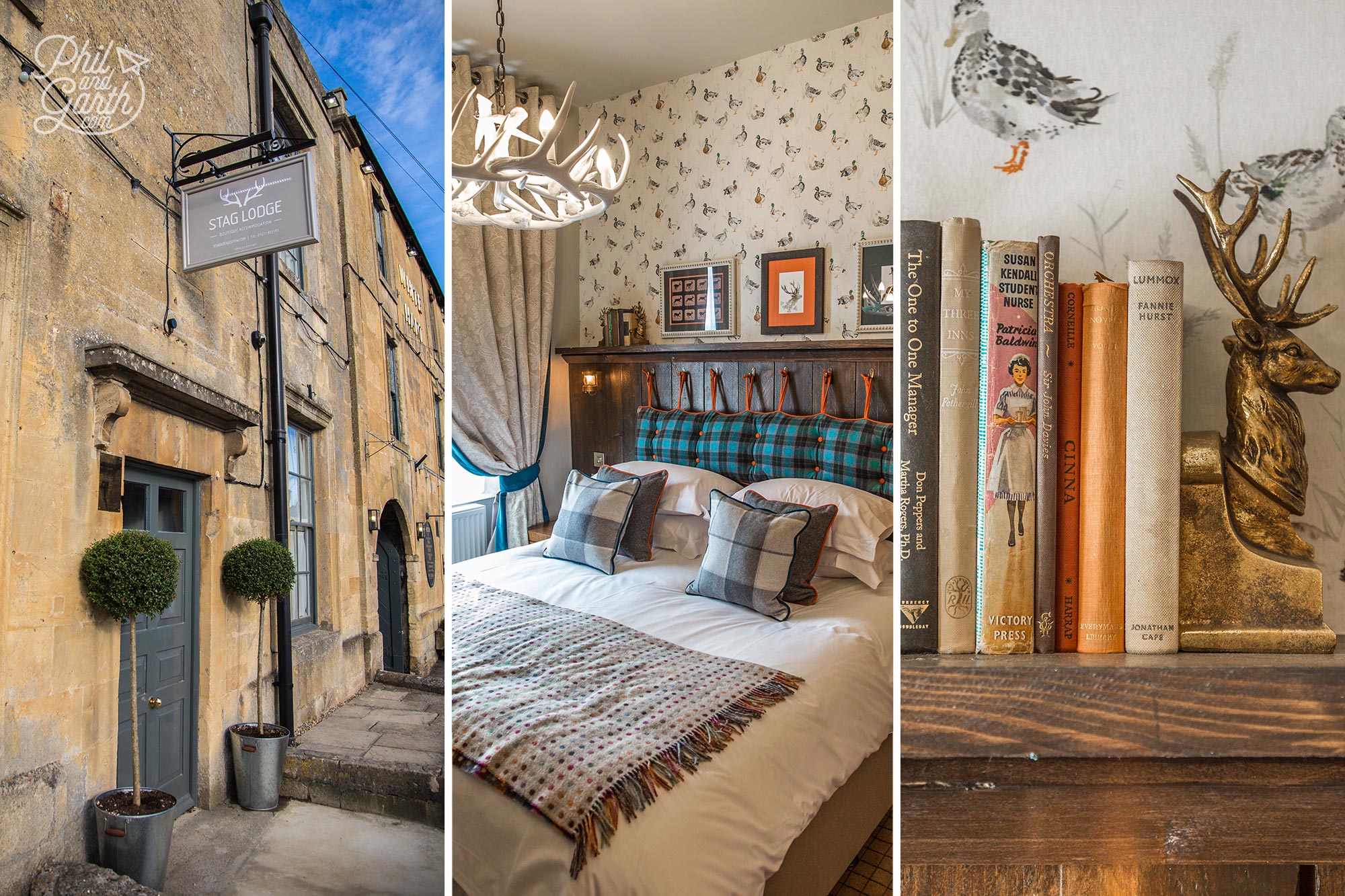
The Stag Lodge – Our chic and affordable accommodation
We paid for 2 nights at The Stag Lodge. A reasonably priced boutique style hotel, with an extremely tasteful Stag themed decor. We thought it must have been done by an interior designer because of all the lovely details from the wall prints to the typography on the keyring tags, to useful details like USB charging points above the bedside tables, perfect for us techies. Our room had large bed with Jack ‘n’ Jill sinks or should that be Jack ‘n’ Jack sinks! a separate shower and loo. The location was extremely handy for local restaurants we walked to in the evenings. We give it 8 out of 10 P&G points!
Bibury
Our first sightseeing stop was the honey coloured cottages of Arlington Row in Bibury. Built in 1380 as a wool store and converted into weavers cottages in the 17th century. They looked like little hobbit houses, and were absolutely charming. At the end of the row around the corner was a bright yellow car, which belongs to a resident, it has become famous and even made it to the national papers for being a blot on the landscape!
If you hold a newer UK passport, check out the inside cover which has an illustration of the Arlington Row cottages, albeit in a weird blue colour.
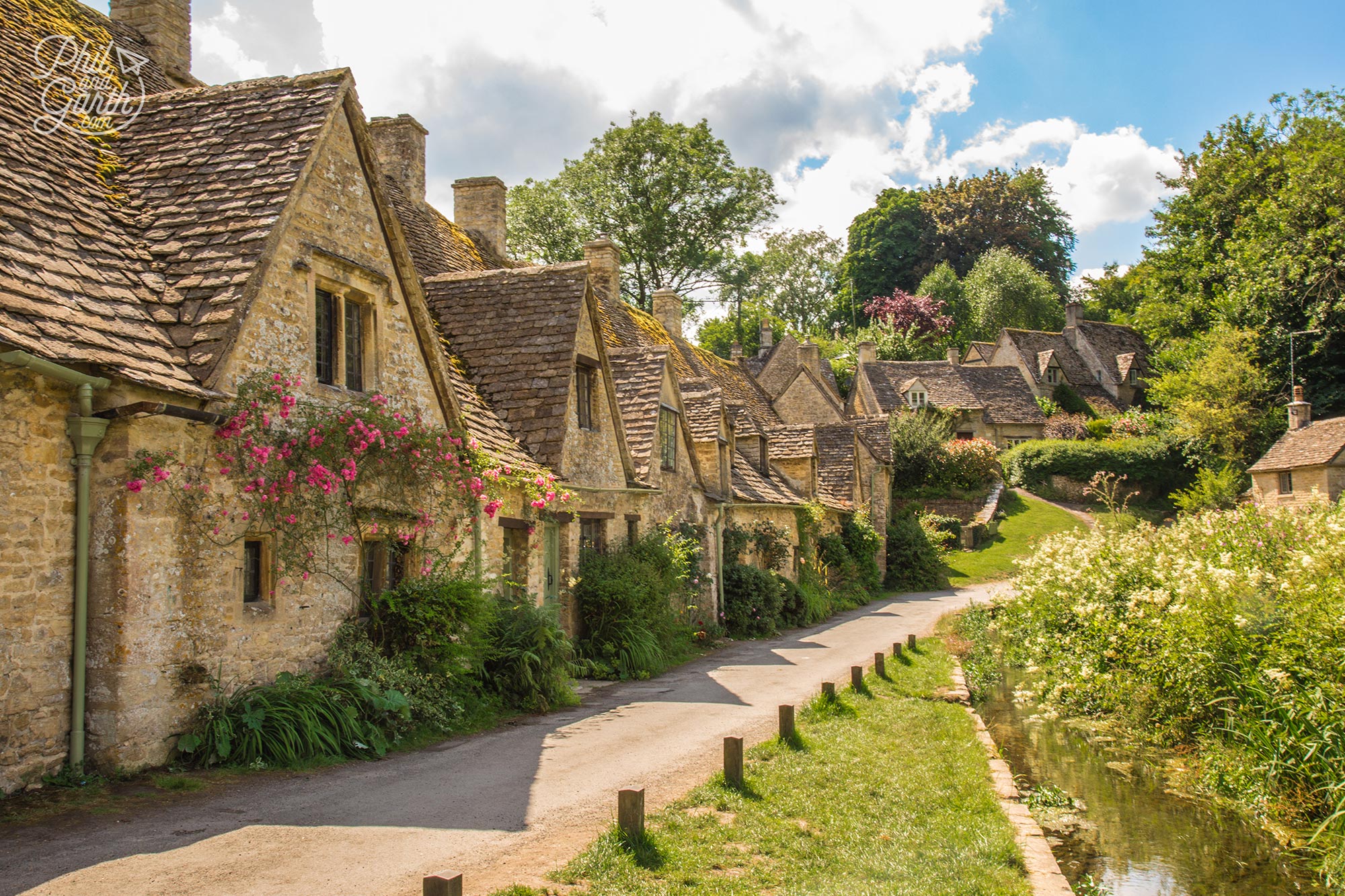
Arlington Row in Bibury
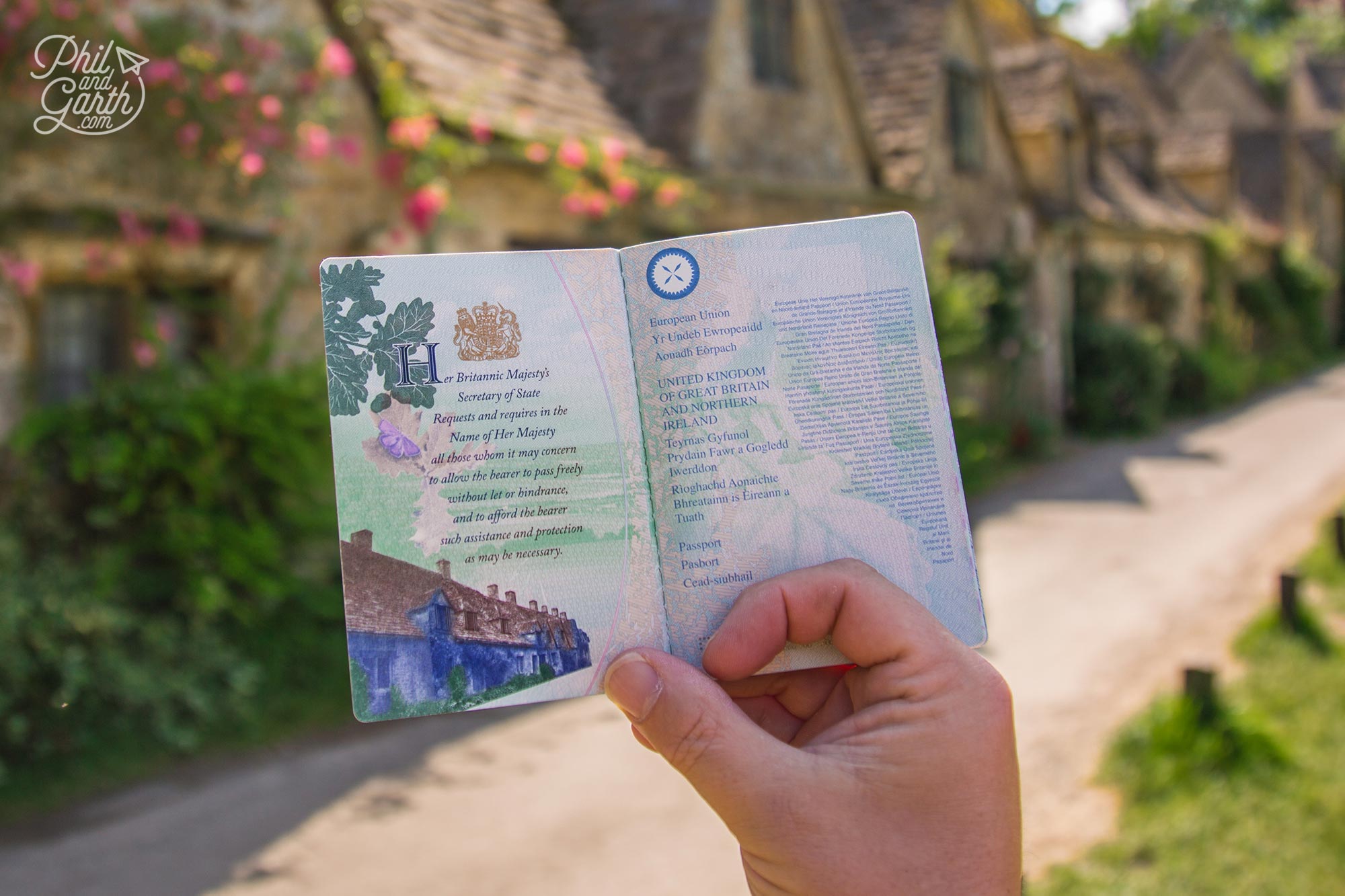
Arlington Row features in the United Kingdom passport
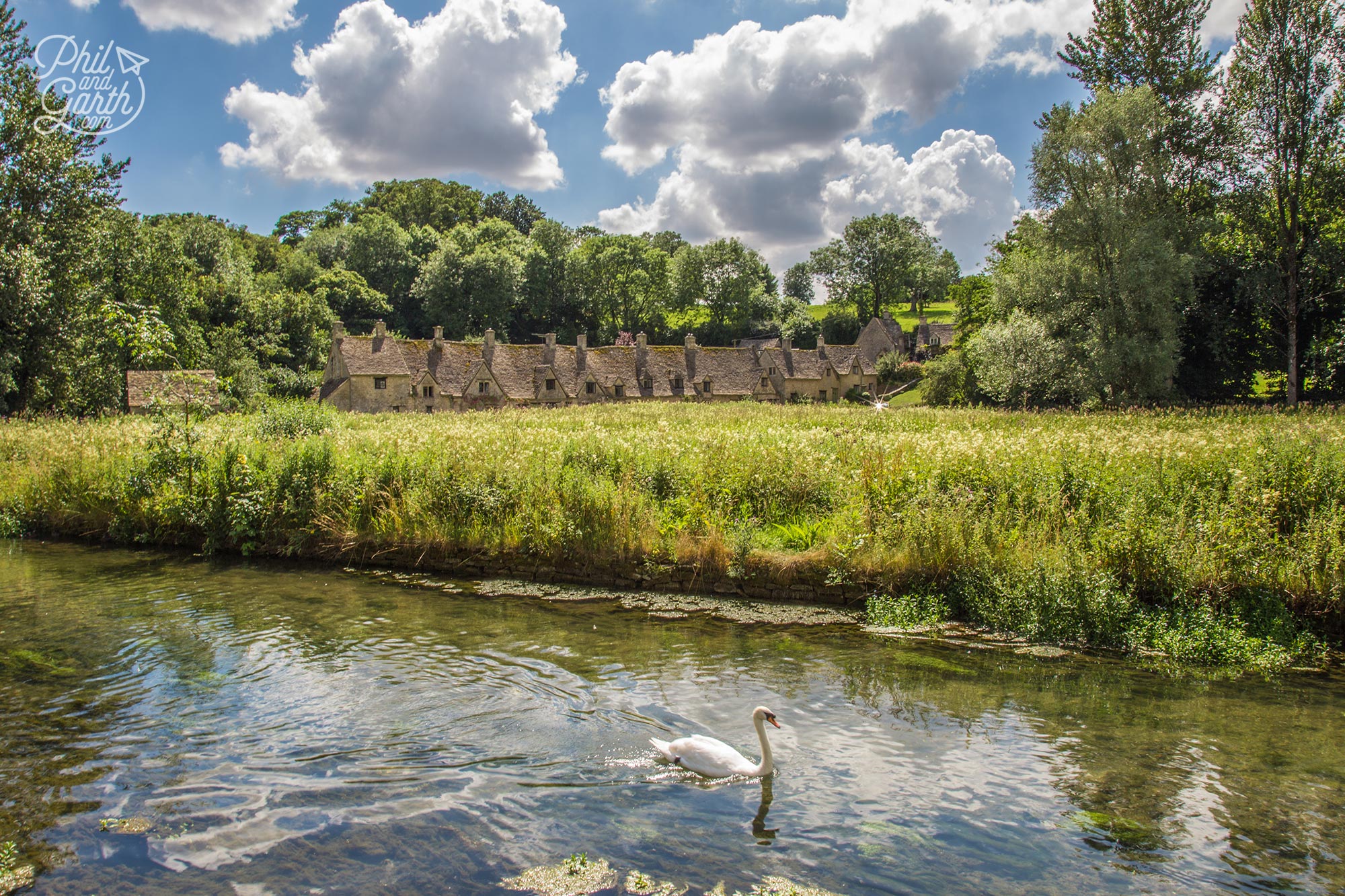
Arlington Row and the River Coln
We loved the tranquility of Bibury with just the noise of the ducks and the odd swan passing by on in the shallow River Coln. The rest of the village had chocolate-box houses and was so quintessentially English. Bibury was a real highlight of our weekend.
Bibury must be loved by photographers, as there’s just so many directions to point your camera, like walls clad with ivy or rambling roses. It was described by the 19th century artist William Morris as ‘the most beautiful village in England’, we certainly agreed with that statement.
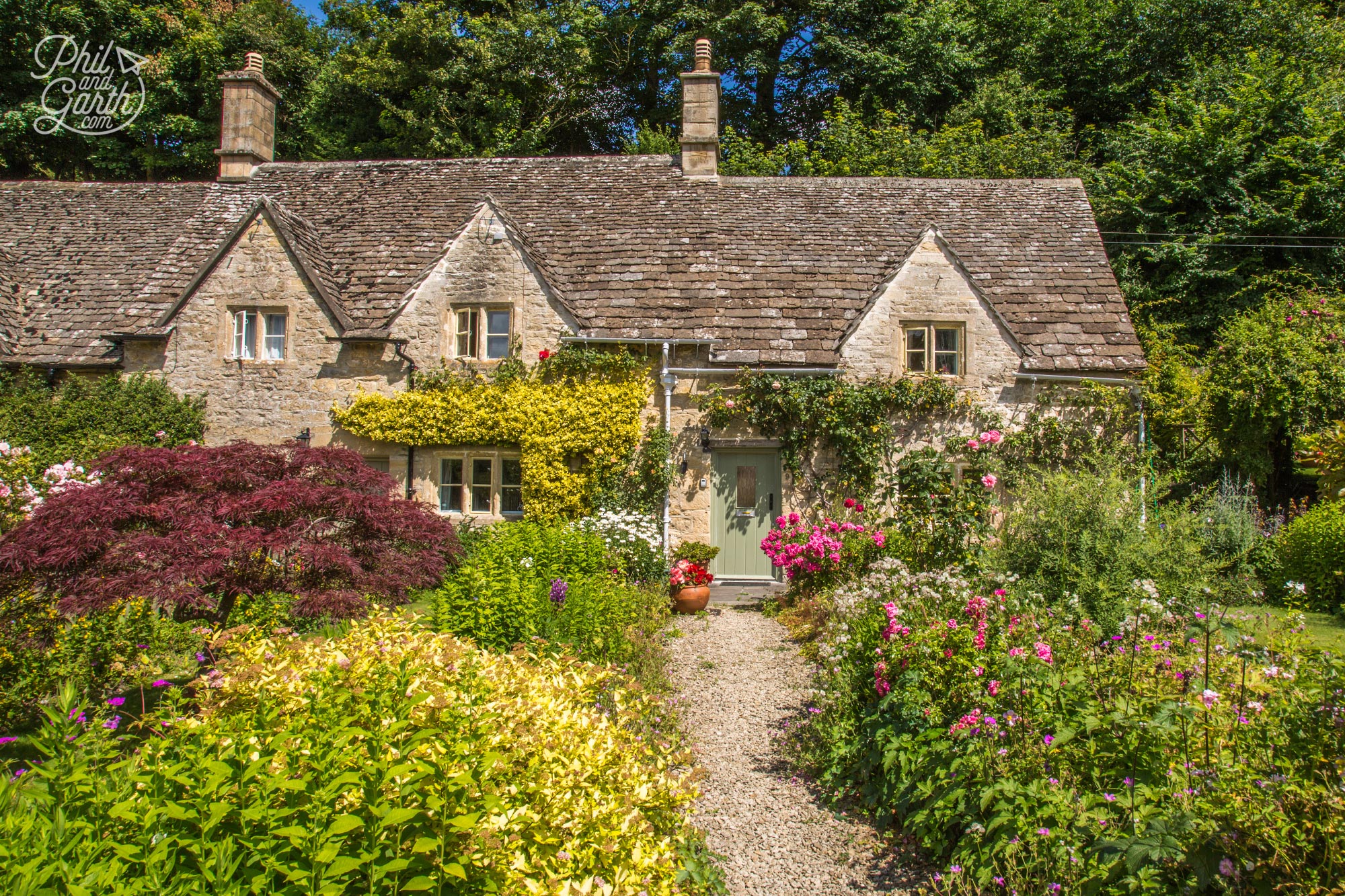
Well manicured English country cottage gardens at Bibury
Cotswold Lavender Farm
Cotswold Lavender is a farm near Snowshill it’s an incredible sight with wonderful smells! The farm had beautiful fields planted with different types of Lavender, and they made for great photos. They harvest the flowers and make their own products, like tea, soap and even chocolate. We read about how they do it in their distillery or you can see it if you get there during the harvesting season. Now for the important bit if you want a good pic – get there early! We got there just before they opened at 10am because we’d read this place gets really busy. It’s true we had the place virtually to ourselves then by 10:30am the fields were full of coach loads of tourists, so it has obviously become a major tourist attraction in the area in season.
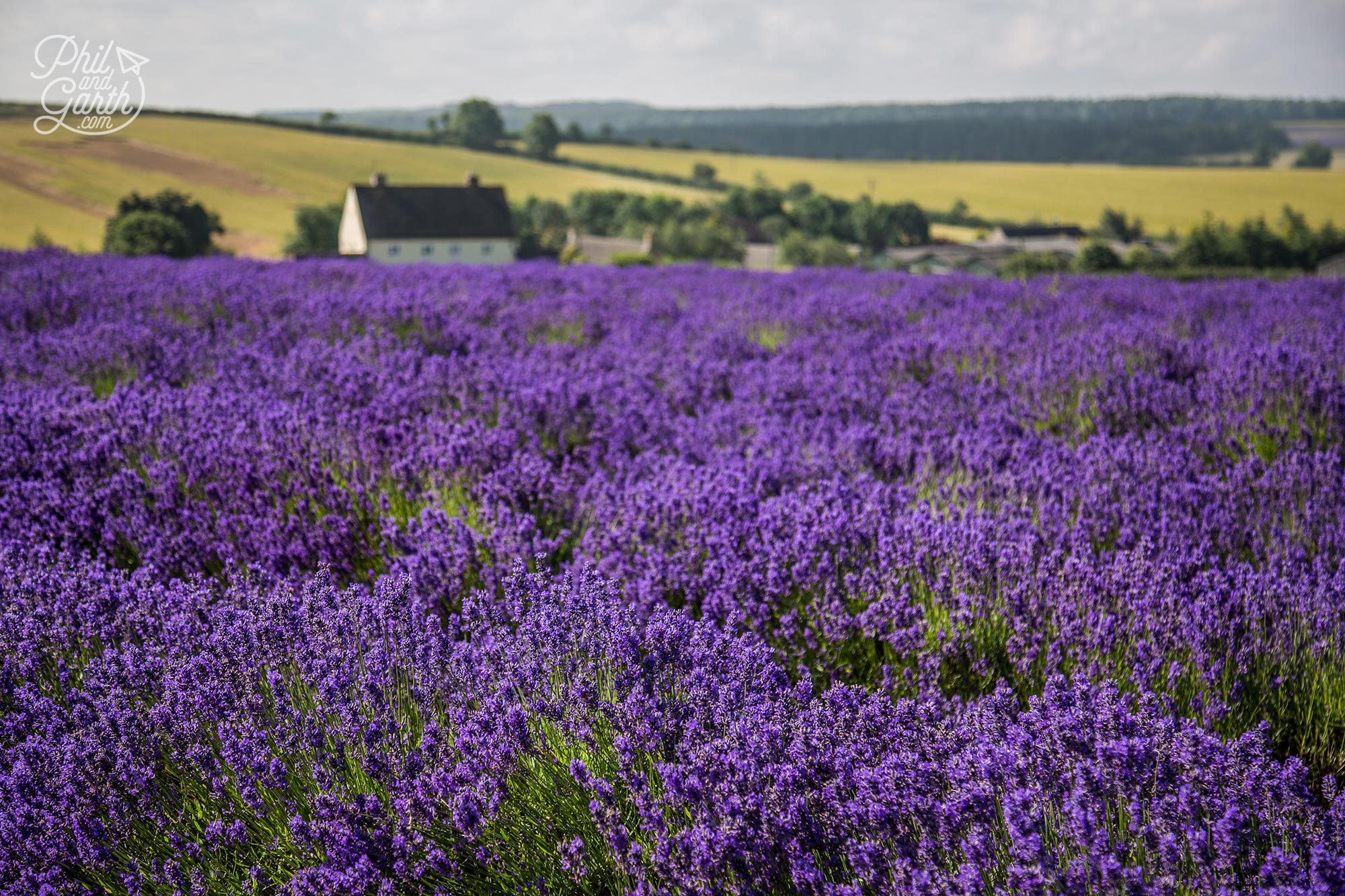
English Lavender fields
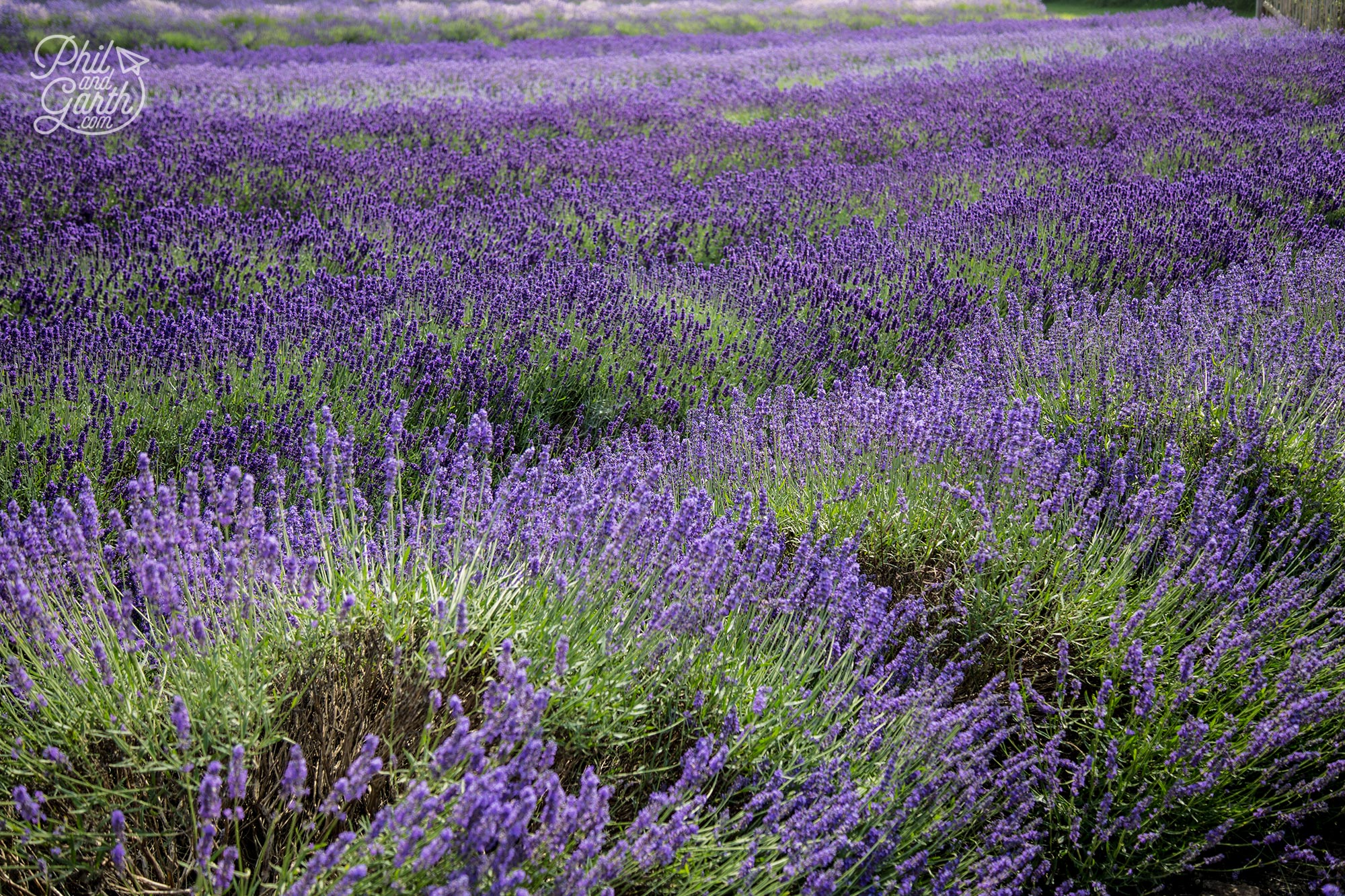
Rows of different types of lavender
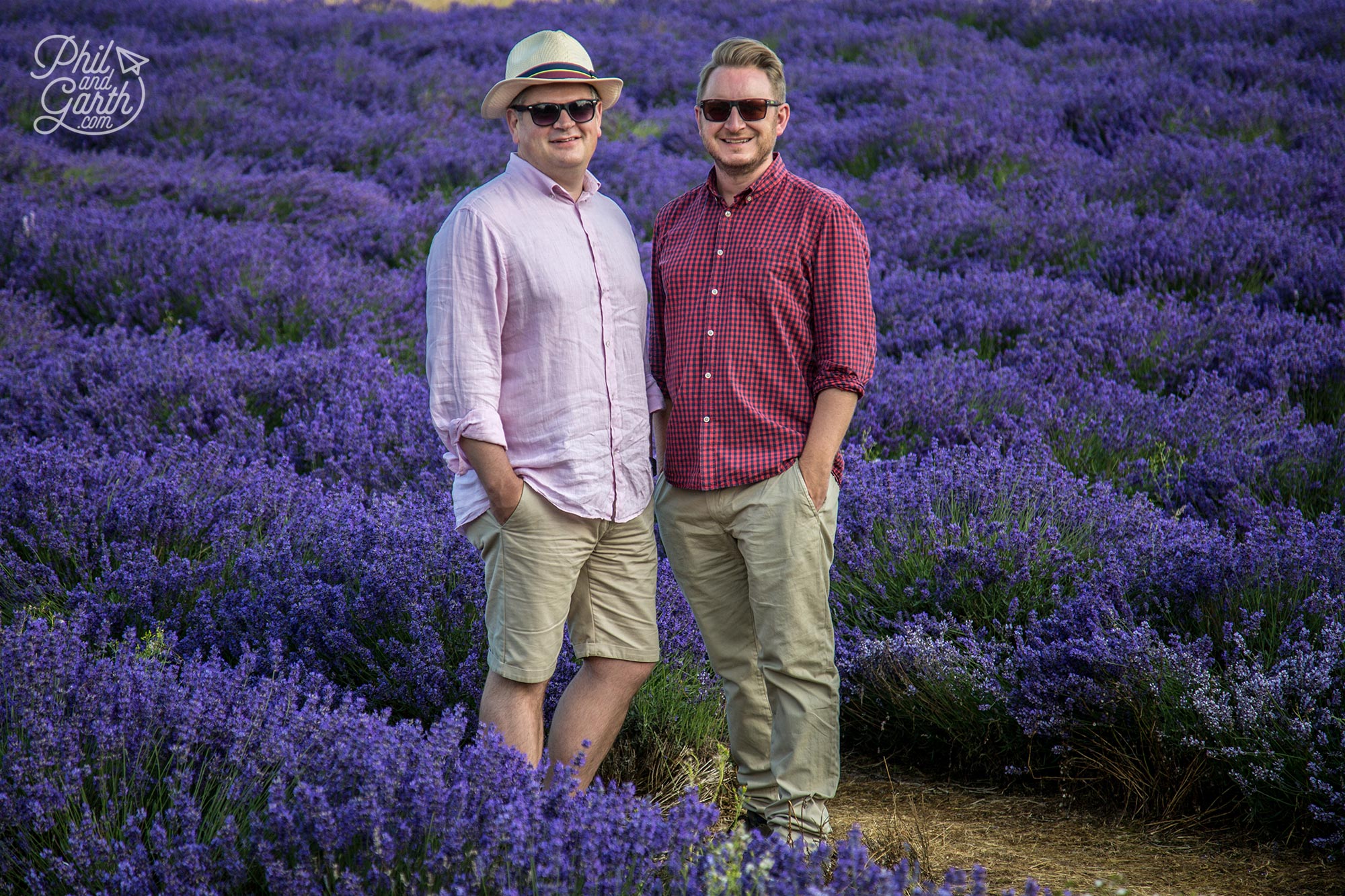
Phil and Garth at Cotswold Lavender
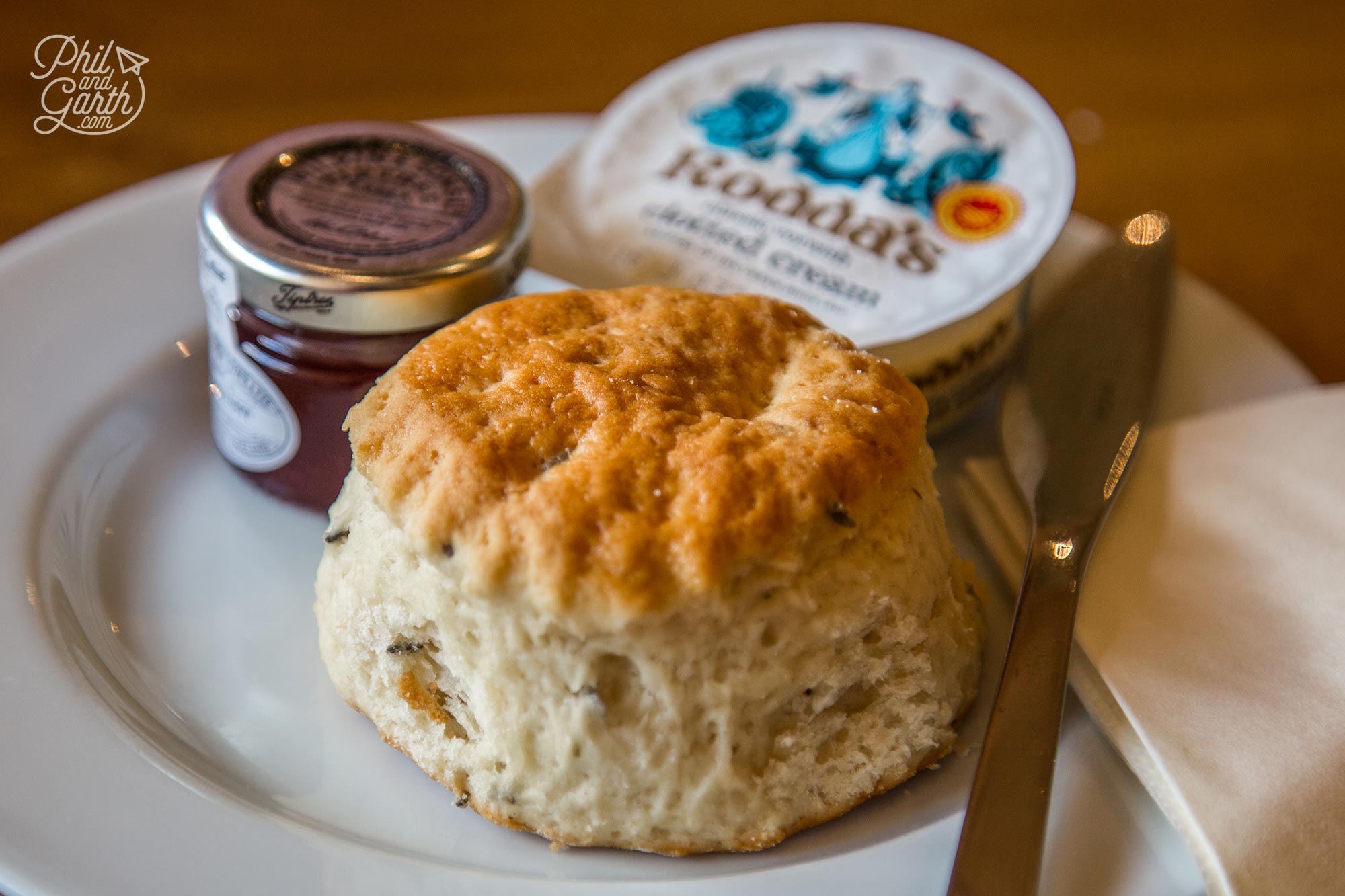
Delicious cream tea – Can you see the flecks of English lavender in our scones?
Before leaving we visited the cafe and tried their lavender infused scones. Phil thought they were delicious, Garth was less keen – quelle surprise!
Snowshill
Tucked away in the Cotswold Hills is the charming sleepy village of Snowshill. This was our favourite village for being totally quiet and authentic. The village had a lovely green, pub and a church. What makes this village perfect for visiting is that the roads to it are unsuitable for coaches which means no tourists – Hurrah!
The village was covered in fake snow when filming took place here for the Christmas scenes of Bridget Jones’s Diary. Before we left the village we stopped for lunch at at their traditional English pub – Snowshill Arms. We had classic pub grub of scampi and chips, and ham, egg and chips. It was basic but nice!
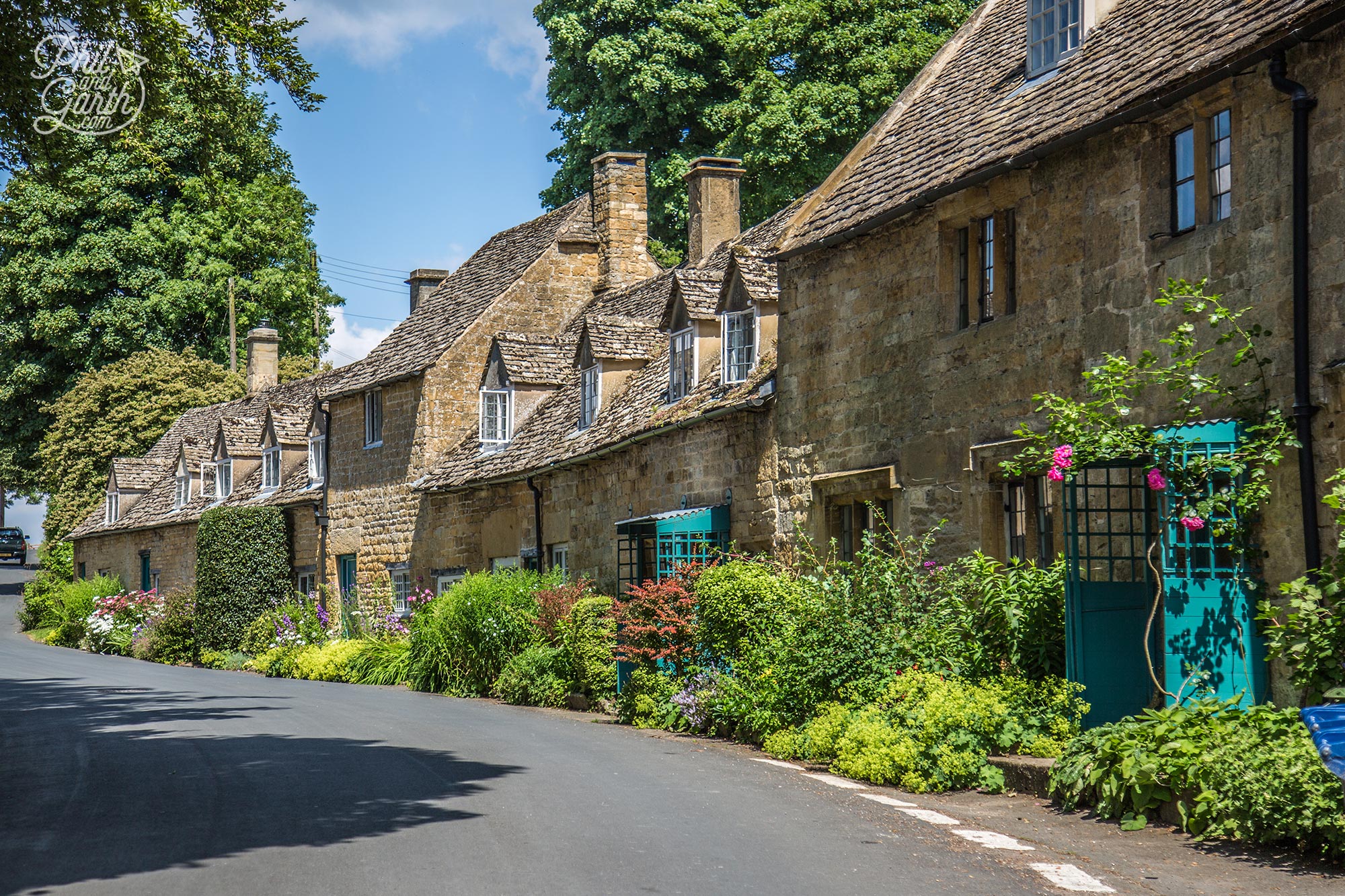
Lovely row of cottages in Snowshill
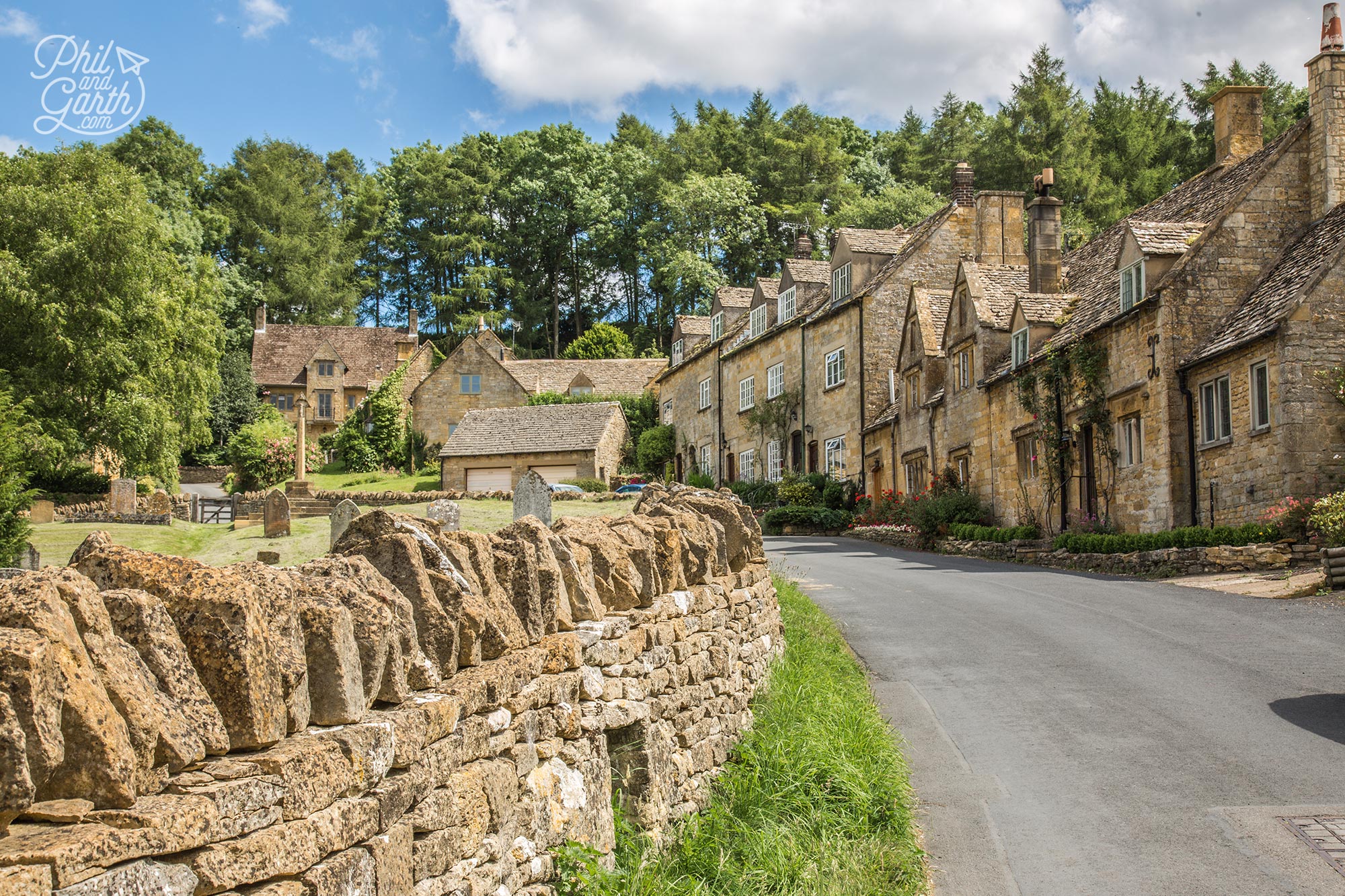
Snowshill dry stone wall and residential homes
Broadway Tower & Nuclear Bunker
Back on the narrow country lanes, we got slightly lost but came across place on the landscape called Broadway Tower, so we stopped and took a look. The cashier asked us if we’d like a guided tour the secret nuclear bunker, much to Phil’s delight and with him being an engineer, he said yes! It was £8 each for both of us, but we figured it was worth it.
The bunker was used to measure and report nuclear attacks right up until 1991 with the threat during the ‘Cold War’ three men would have been based down here and reporting on the attacks that were happening above. The nuclear bunker tour is only open on weekends and bank holidays, check with them first if you really want to visit. It was such a learning experience from the knowledgeable guides.
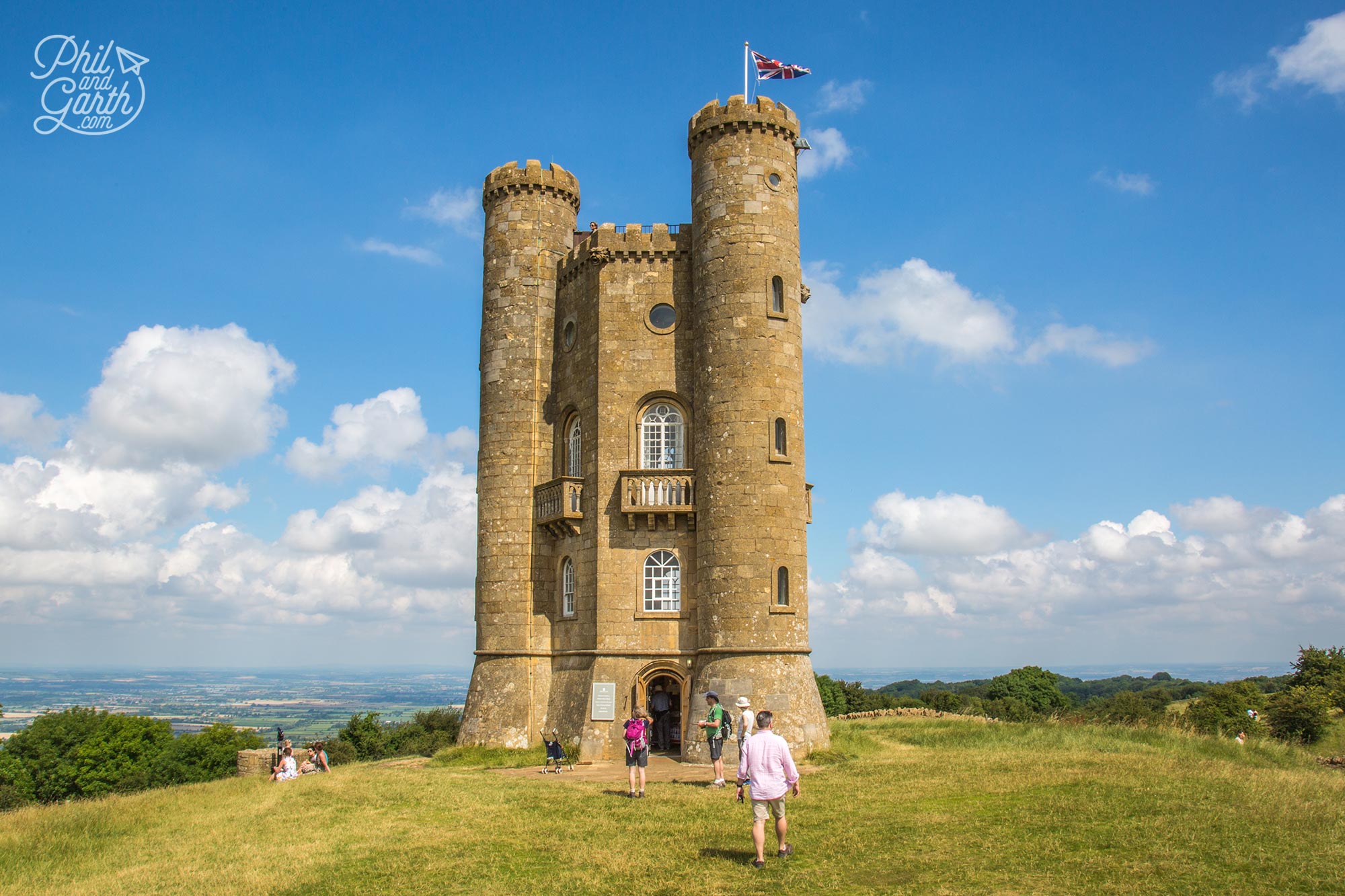
Broadway Tower – the highest castle in the Cotswolds
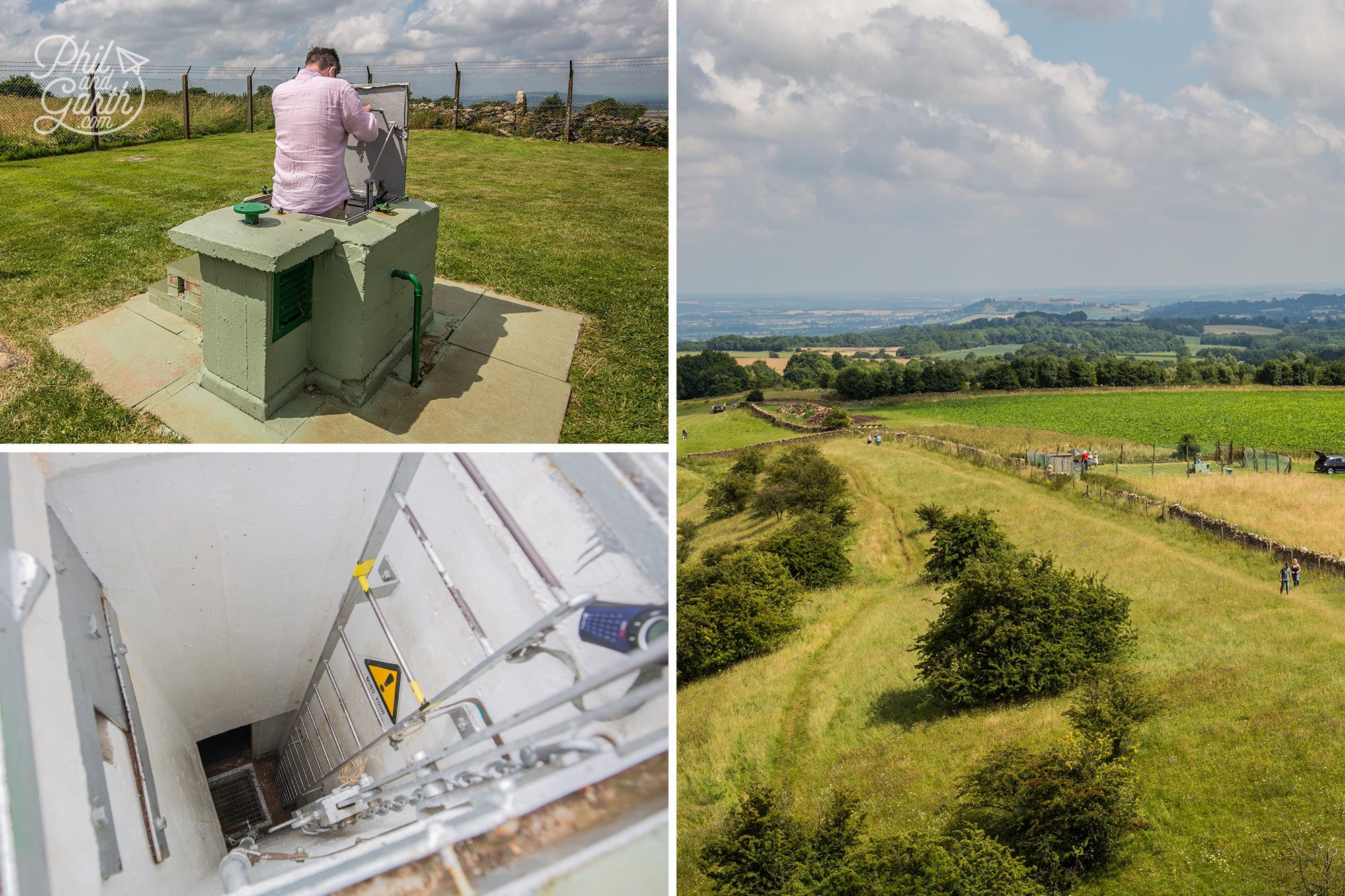
View from the tower of the nuclear bunker, and Phil climbing down the ladder
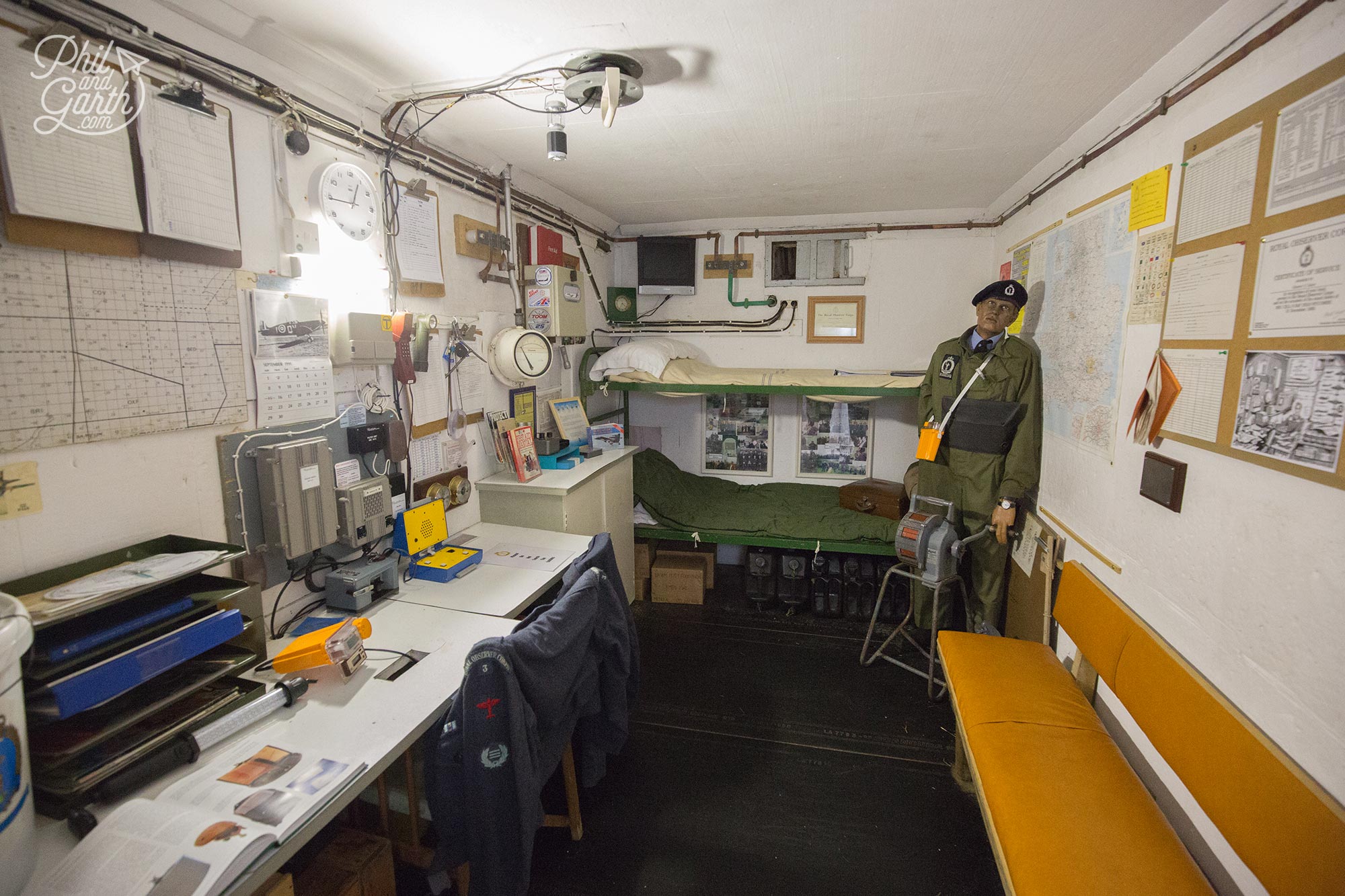
Inside the Broadway Nuclear Bunker
Gifford’s Circus
Following the sat-nav once again, we drove through a lovely little place called Barrington, where there were signs for the circus, so we had to investigate!
Giffords Circus is an old English traditional family circus, that looked just magical, we kept seeing a glimpse of show folk in costume as they moved in and out of caravans, it looked just like a children’s book! Phil checked with their Box Office if we could buy tickets, but sadly sold out for the whole weekend which made us want to see it more. So book early!
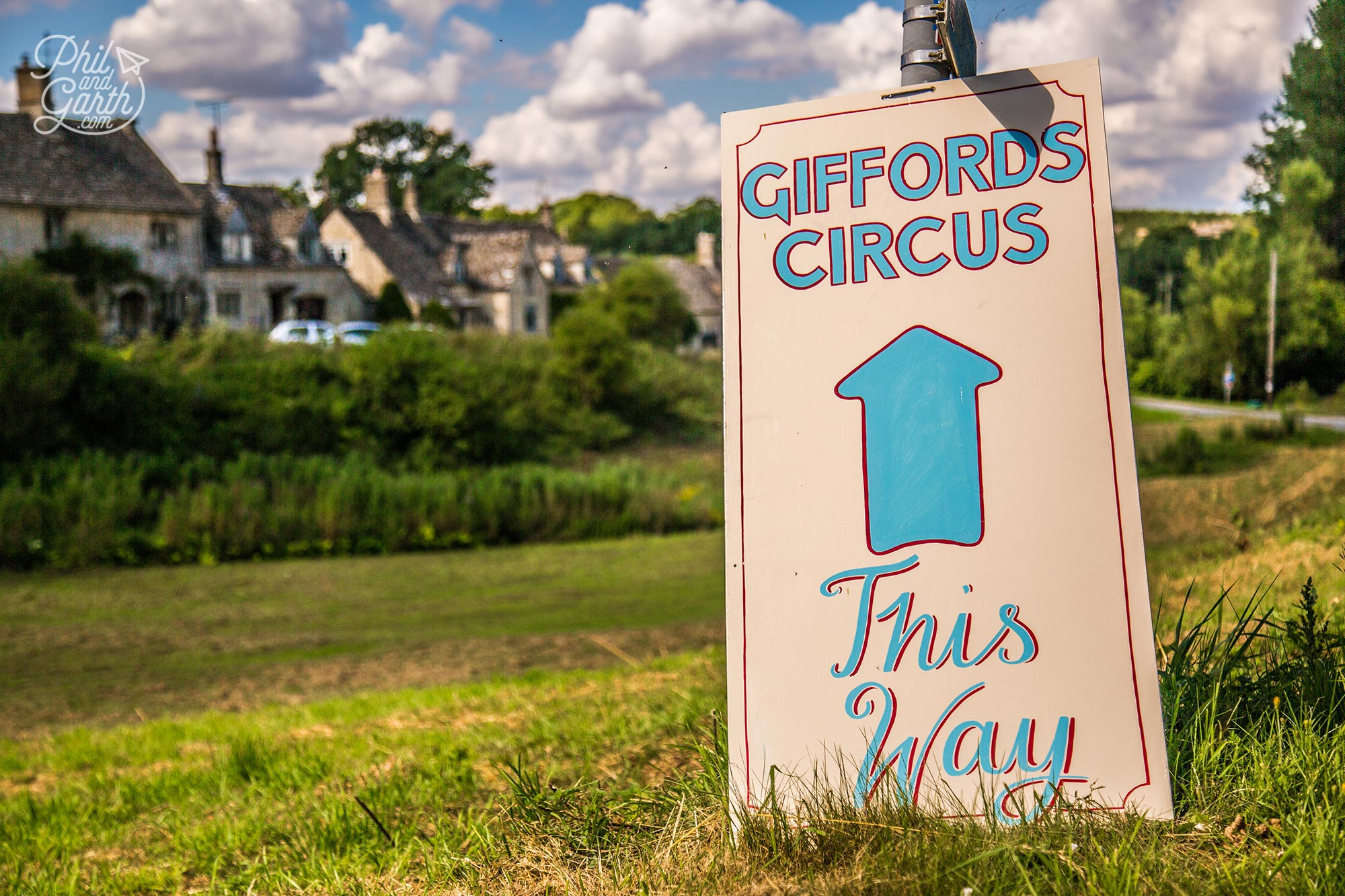
Roll up Roll up! A Giffords Circus sign in the village of Barrington
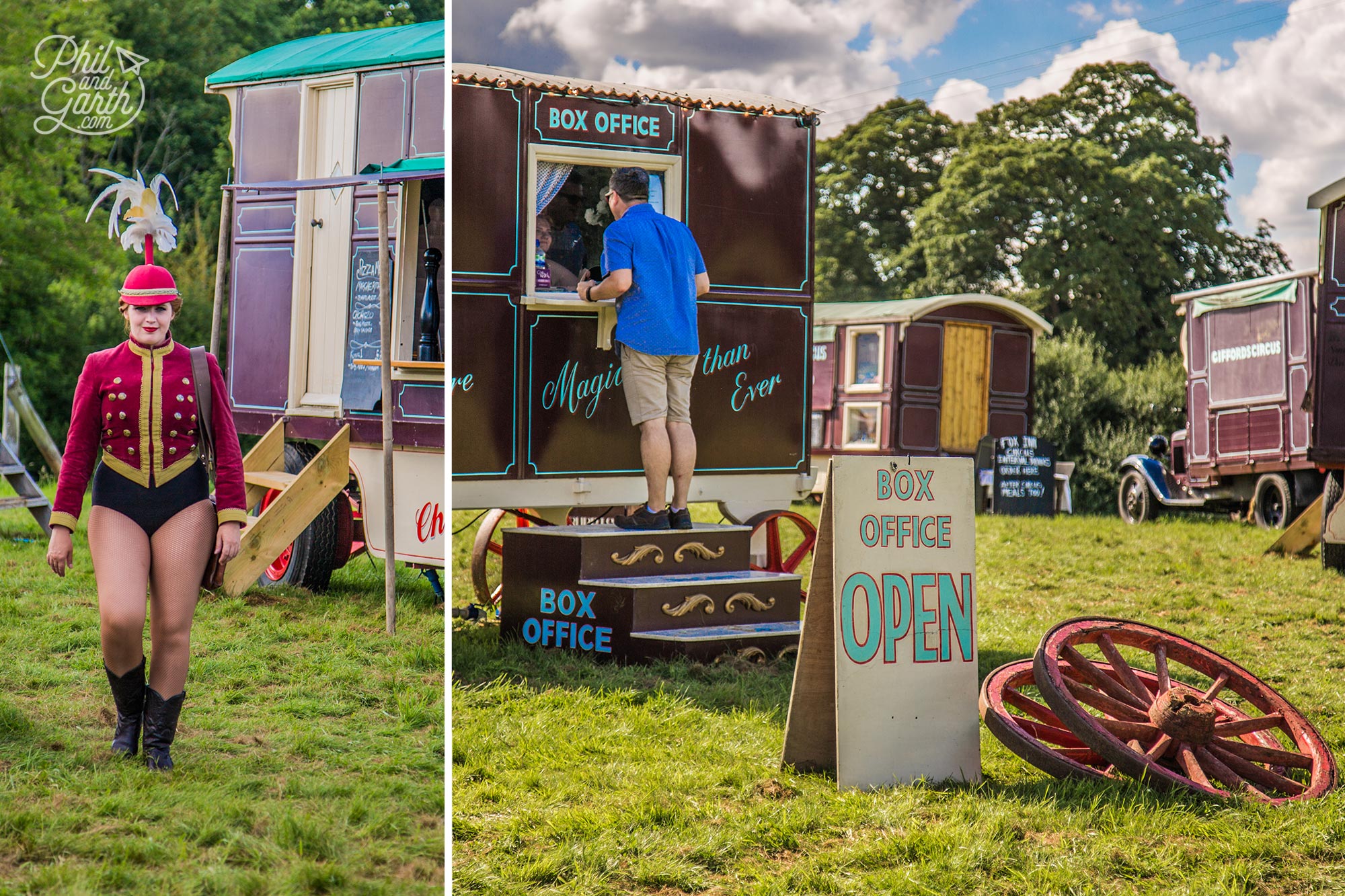
Phil at the Giffords Circus box office
Bourton-on-the-Water
Probably the most popular town in the Cotswolds, Bourton-on-the-Water, was full of tourists on day trips from London, and lots of British family holidaymakers when we visited. Despite it not been the sleepy villages we’d been used to, it still had charm. Five ornamental low bridges line the River Windrush and are the town’s landmark. Postcards sold here describe the town as “Venice of The Cotswolds”.
We took a nice leisurely walk along the banks watching people feed the ducks and families enjoying the shallow water. It was an incredibly hot day, quite rare for England! and a bit too crowded for us, so we didn’t stay long. But we thought it’s a perfect destination for families as there are lots of other attractions including a maze, motoring museum, exotic birds, a model village and a perfume factory.
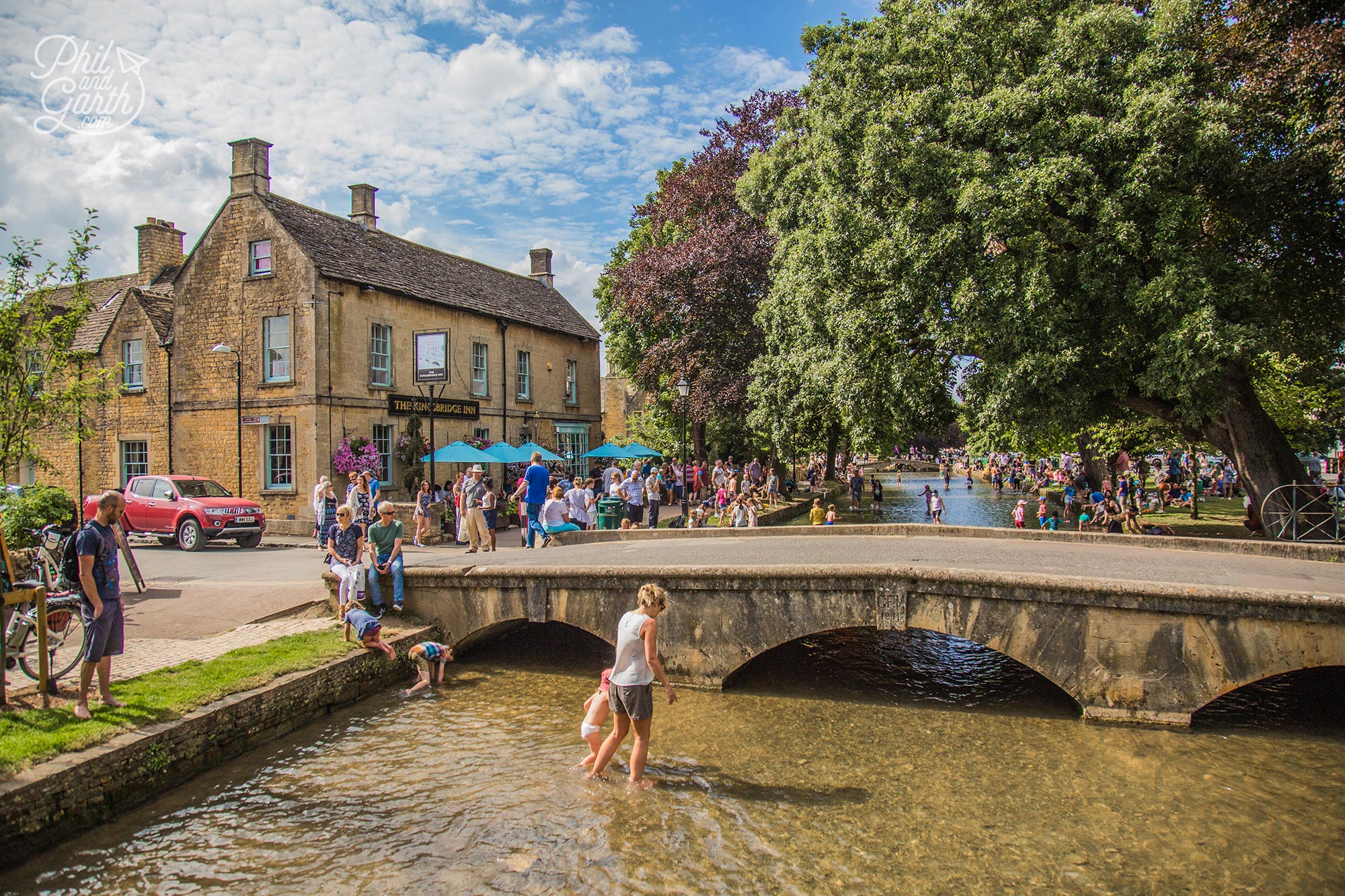
Signature low bridges of Bourton-on-the-Water
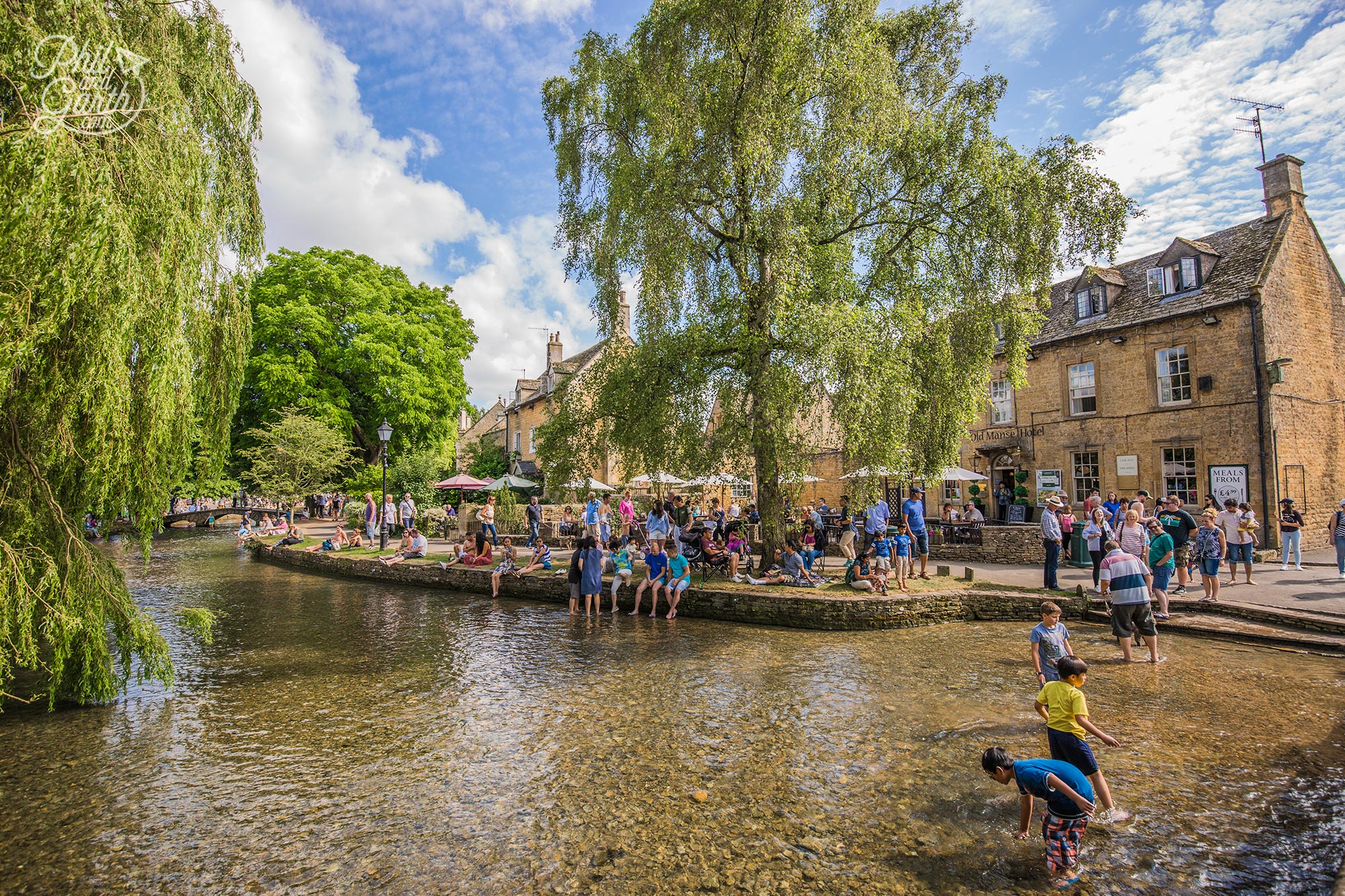
Pretty Bourton-on-the-Water
The Slaughters
Just a few minutes from Bourton-on-the-water were the villages of Upper and Lower Slaughter. They were more up our street, wonderfully pretty and idyllic. The name ‘slaughters’ descends from the Old English, meaning ‘‘muddy place’ i.e. wet land, and are not connected with some non veggie friendly past as their names suggest! We took a gentle stroll following the shallow River Eye along Copse Hill Road in Lower Slaughter, which was voted “Britain’s Most Romantic Street” by Google in 2011. It’s true! the village did have a romantic ambience with the odd couple here and there having a picnic.
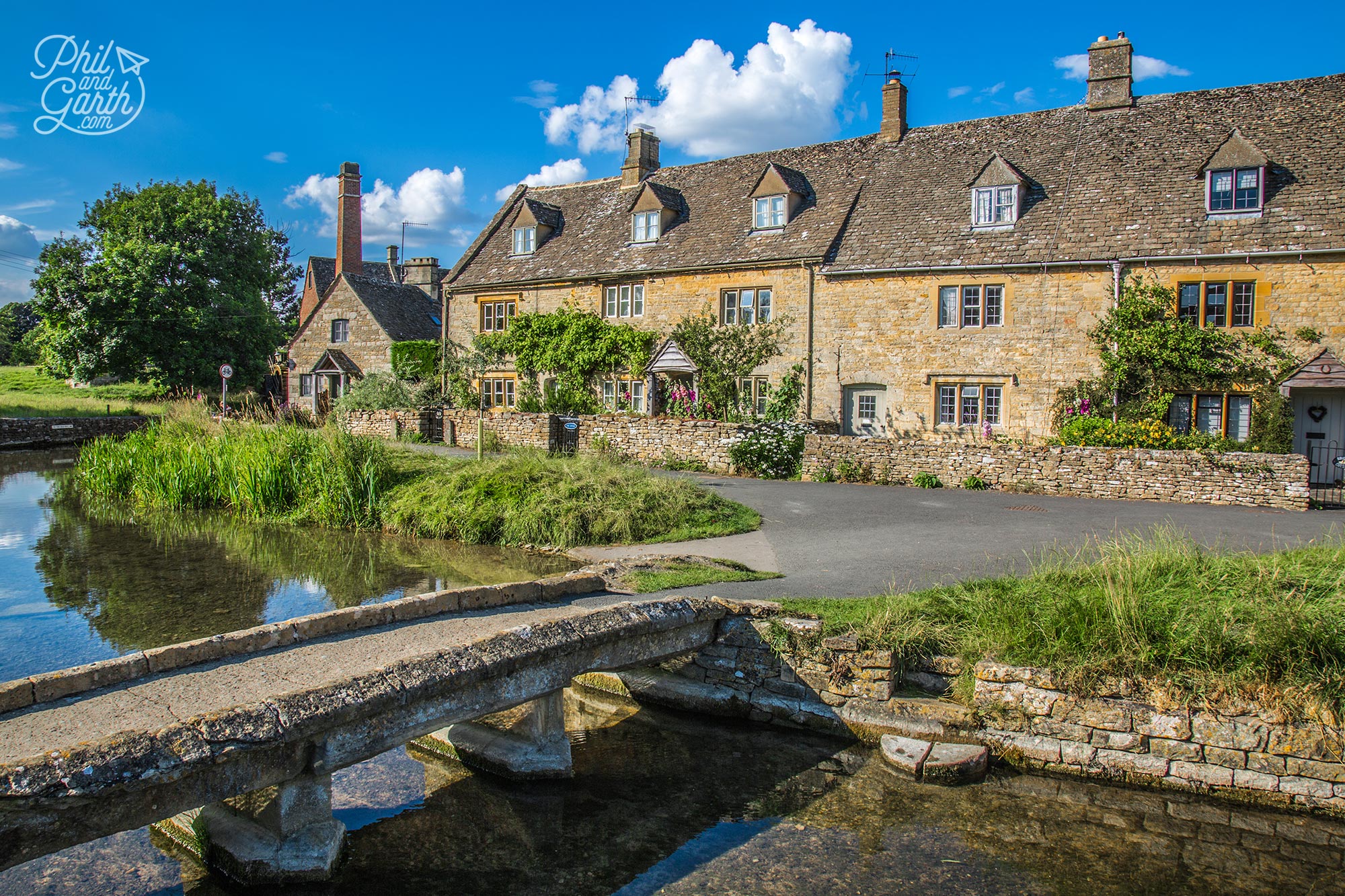
The quaint cottages of Lower Slaughter
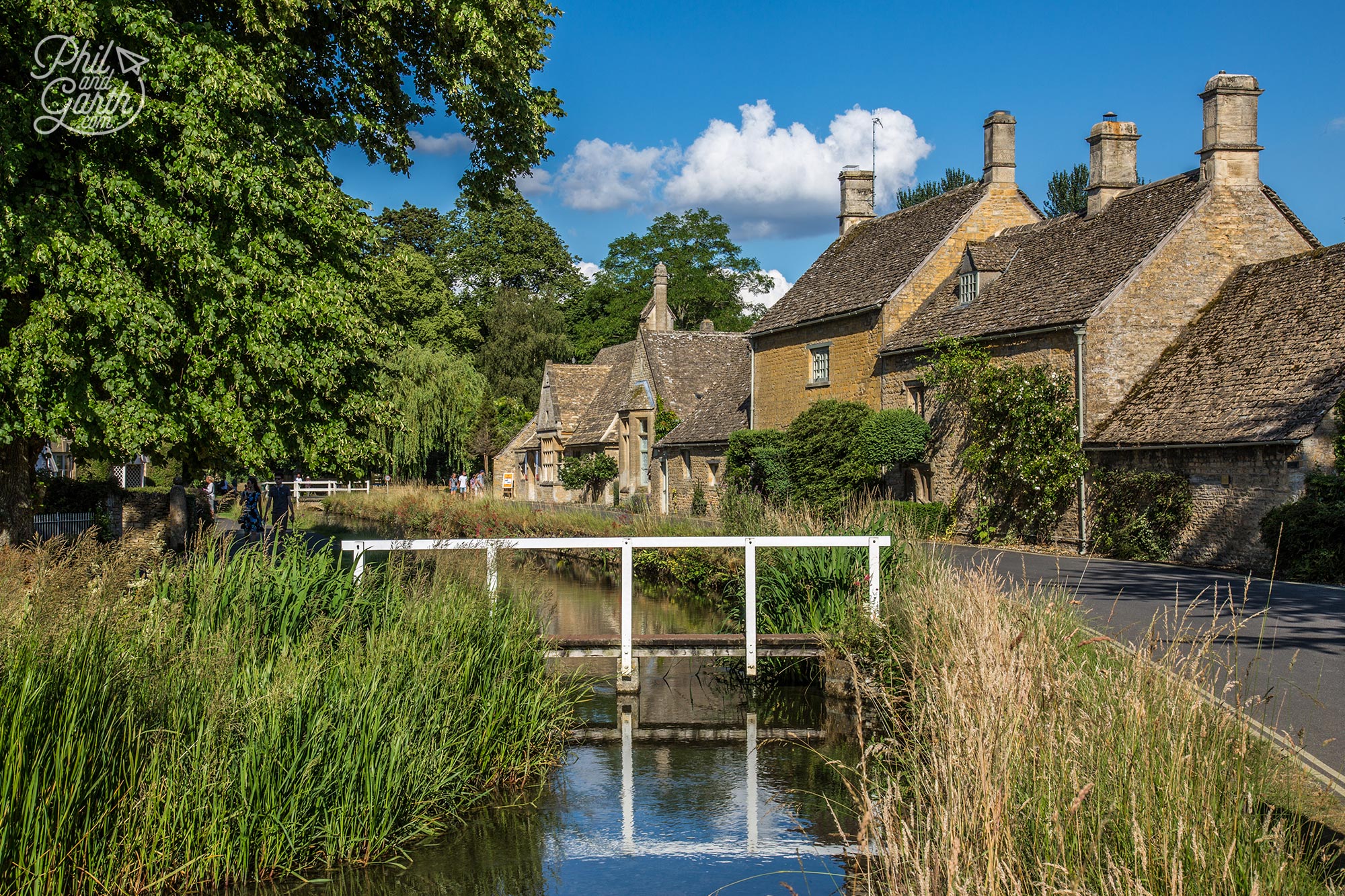
Picturesque Lower Slaughter
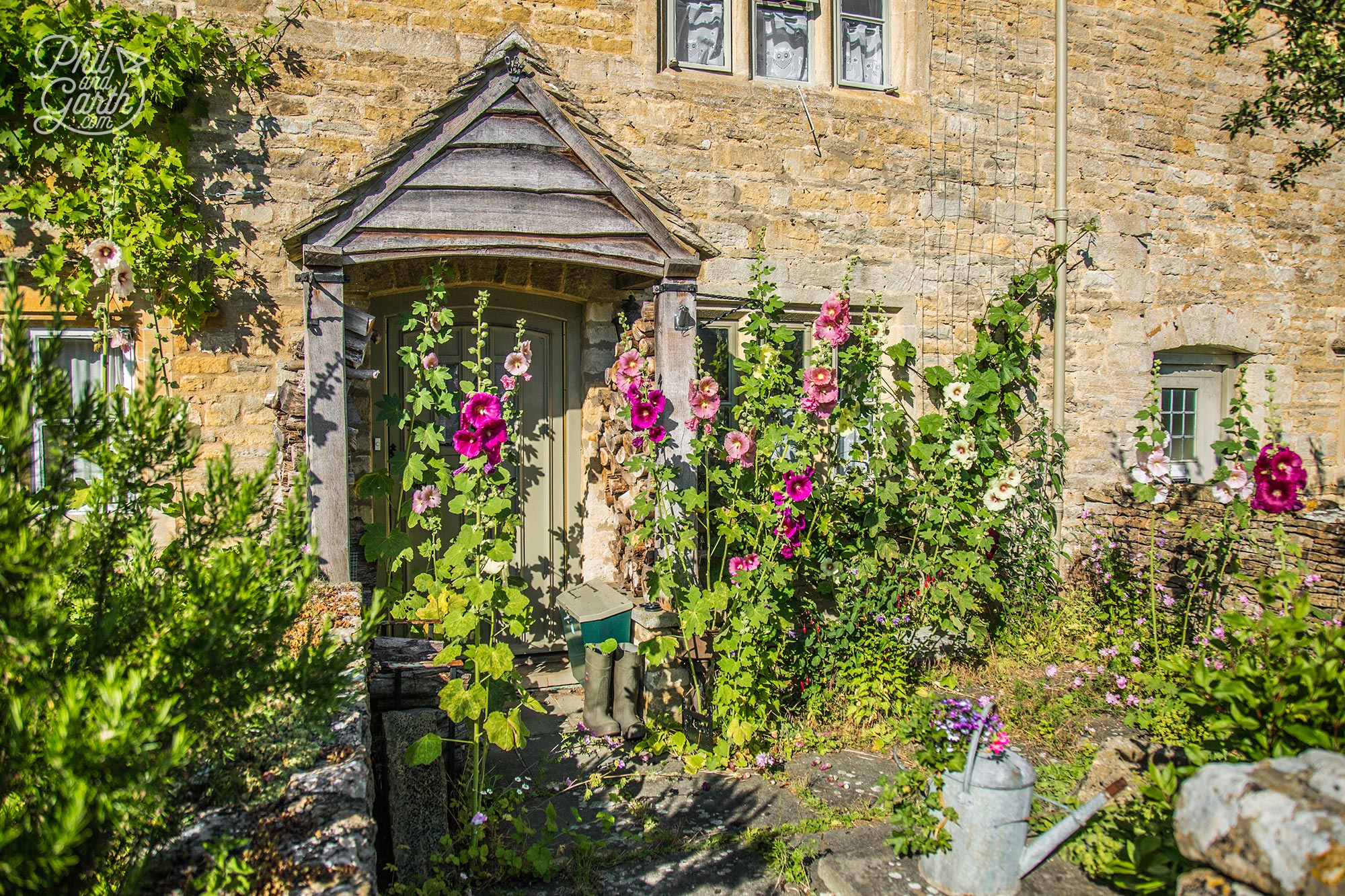
Hollyhocks in full bloom
We have a cottage style garden at home and Lower Slaughter provided plenty of inspiration for us to take home. Some of the best examples of English country gardens are here. Tall Hollyhock flowers seem to be the over-riding theme in the Cotswolds. Phil had serious hanging basket envy as they were all overflowing with flowers, unlike ours.
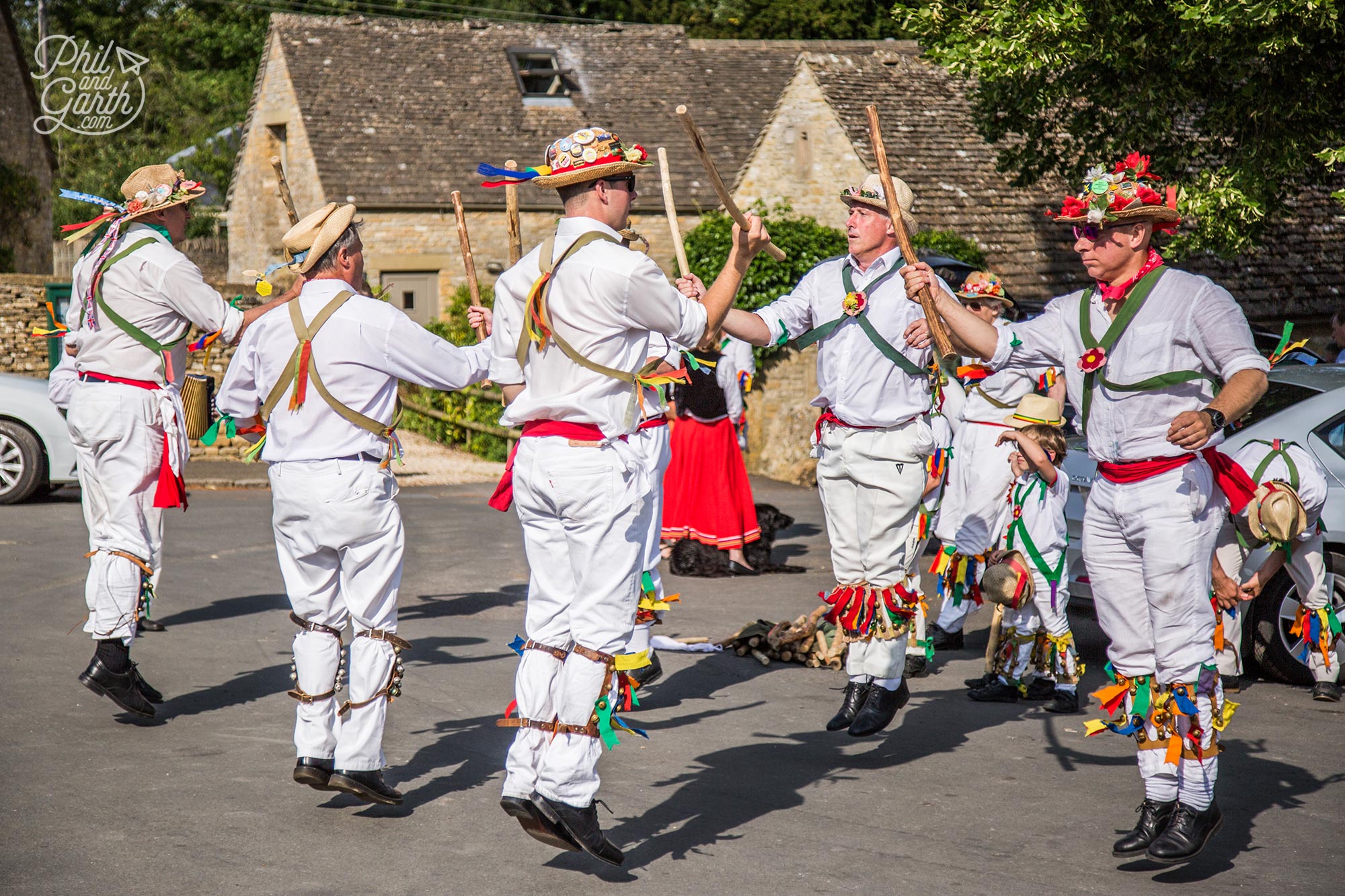
Traditional Morris dancers in Upper Slaughter
Before leaving Lower Slaughter we stopped for ice cream at the The Old Mill, a former corn mill which is now a tea shop. To cool down we ordered two amazing caramel shortbread flavour ice creams. We carried on following the river to Upper Slaughter which links the two villages and discovered Morris dancers – how English (and a bit camp too!) very entertaining, it’s great these old traditions are kept alive by a few locals. We loved that both villages were free from hoards of tourists and shops, instead just really peaceful and authentic.
Chipping Campden
This was another important market town, where wool traders came from around the world to buy Cotswolds fleeces. “Chipping” in Old English means Market. The town had a really long and wide high street with ancient buildings lining it on each side, we liked it but definitely preferred the smaller villages.
We had a look at the market Hall built in the 17th century, 1627 to be exact, and amazingly still used by traders today. Everything was so intact and we imagined how the town must have been full of horse and carts and sheep back in the day instead of cars. We found lots of bookshops and antique shops, as well as some cute homeware shops.
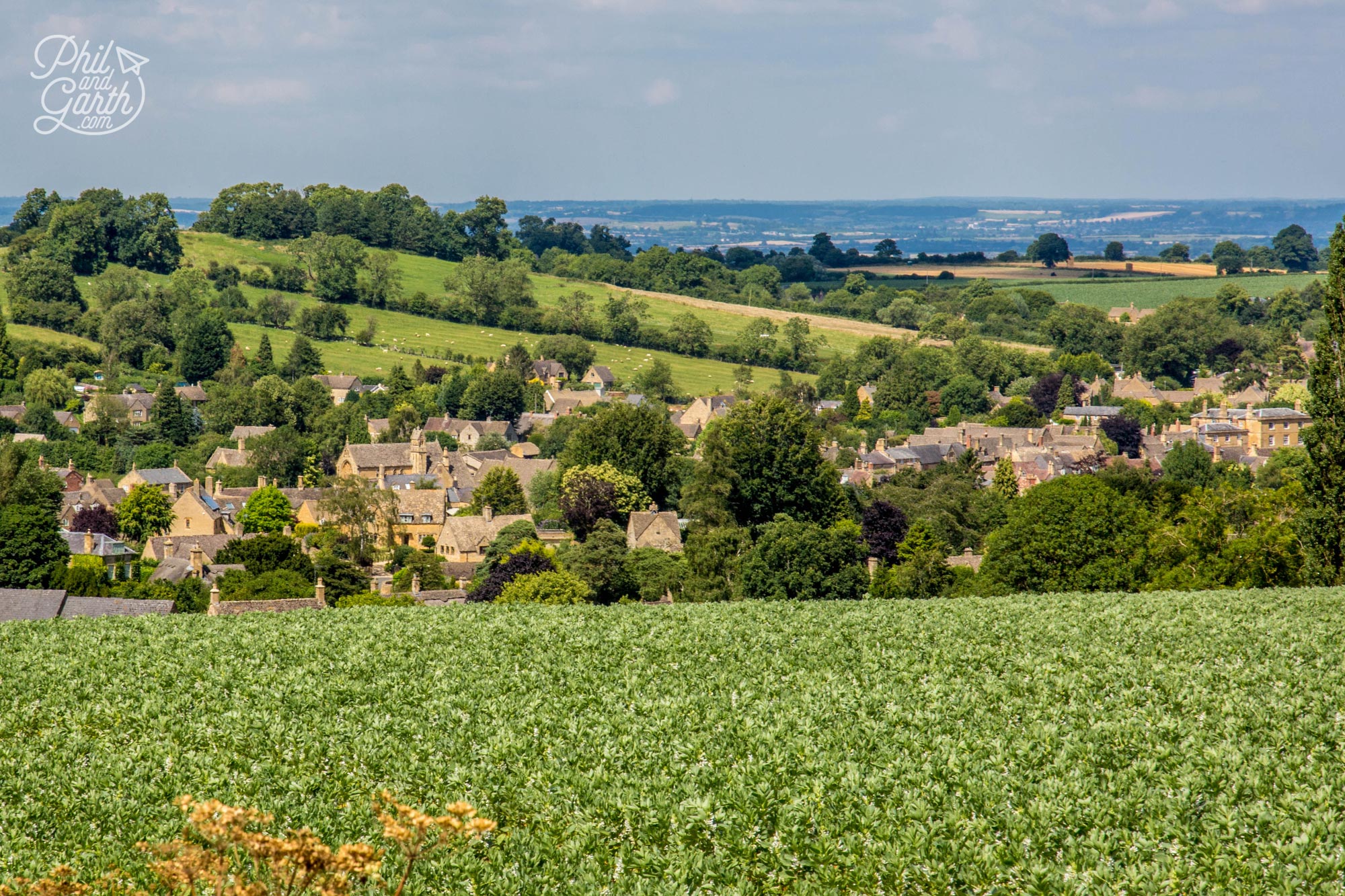
View of Chipping Campden
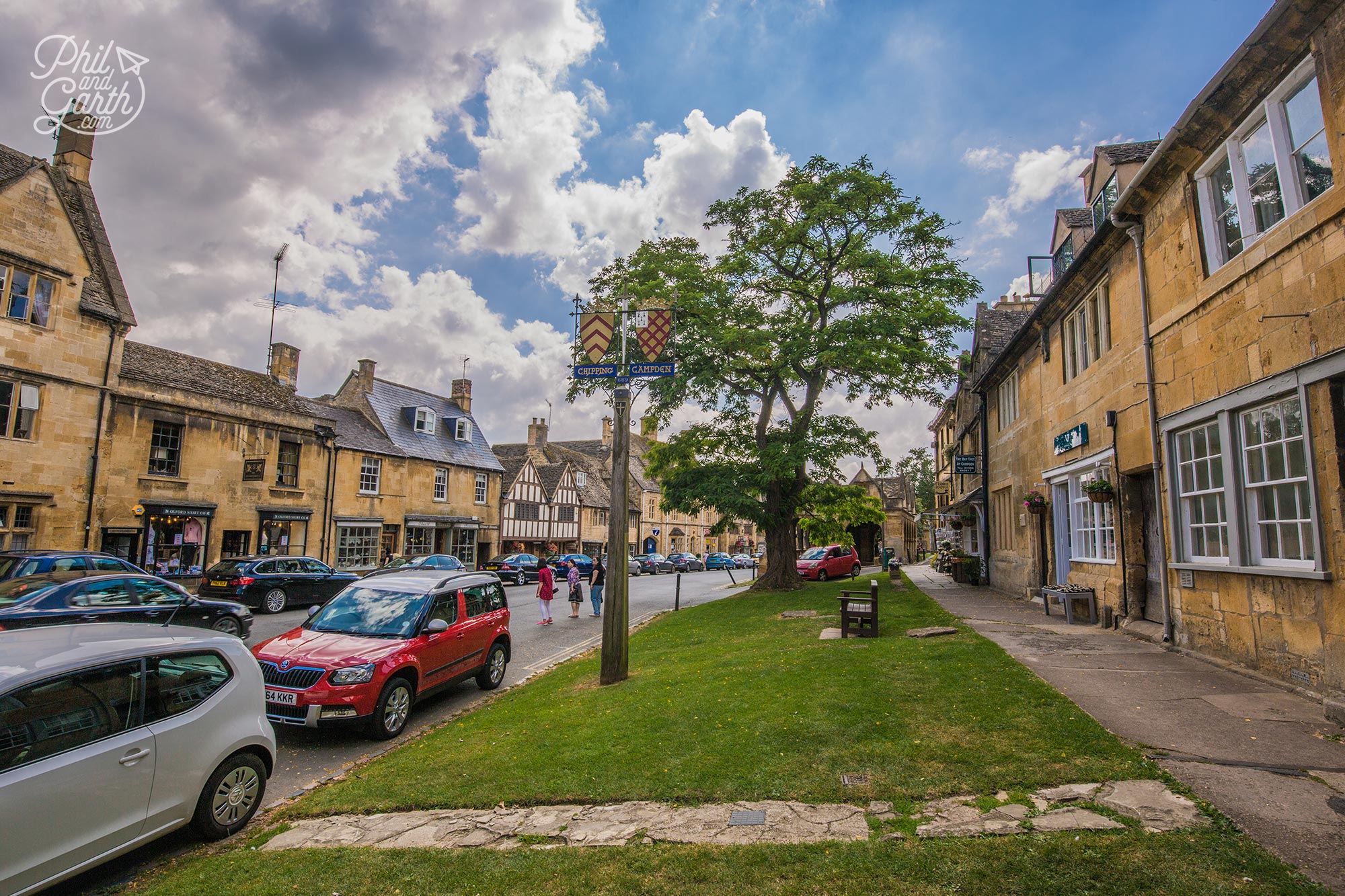
Chipping Campden high street
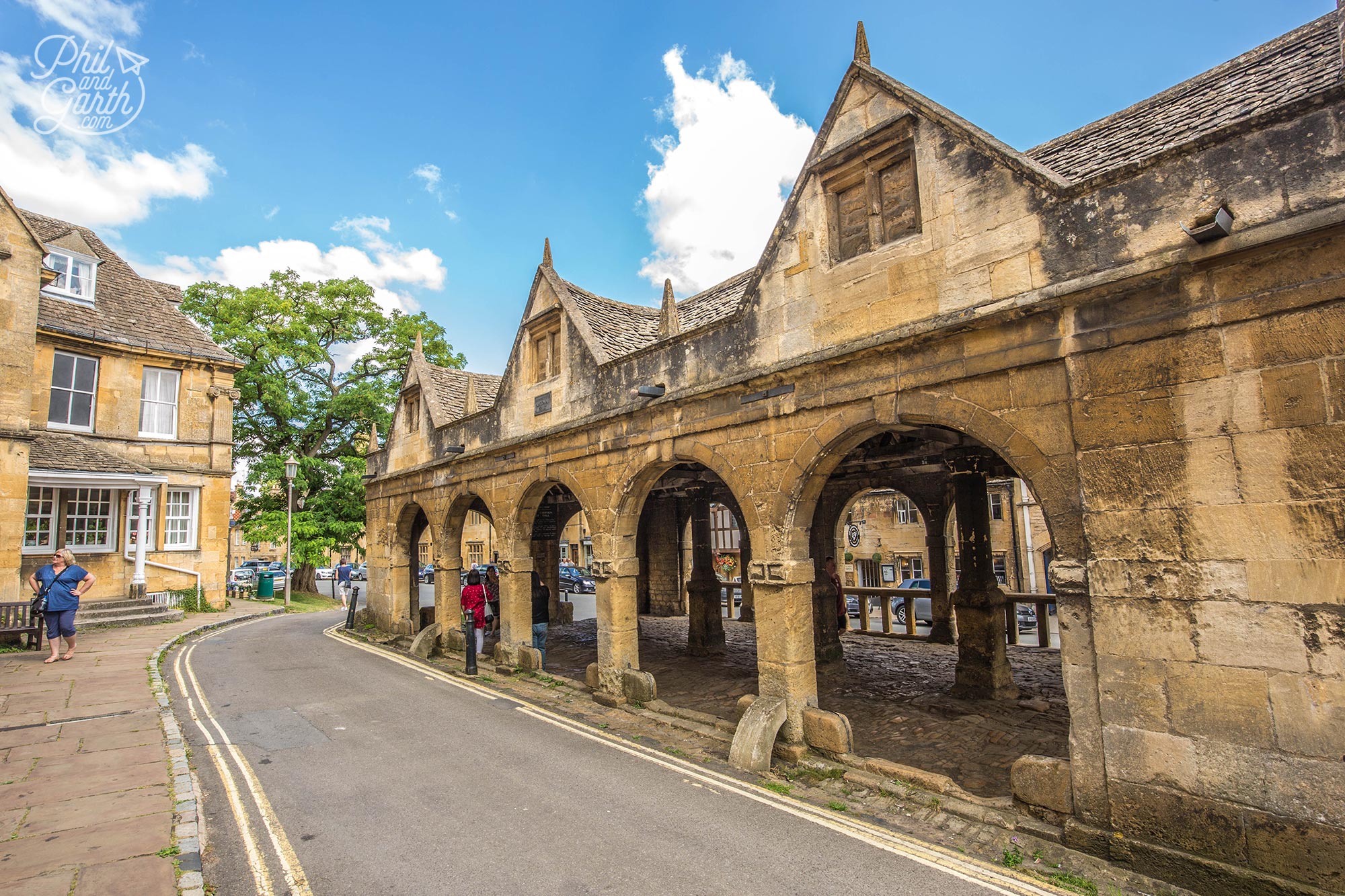
Chipping Campden’s historic market hall
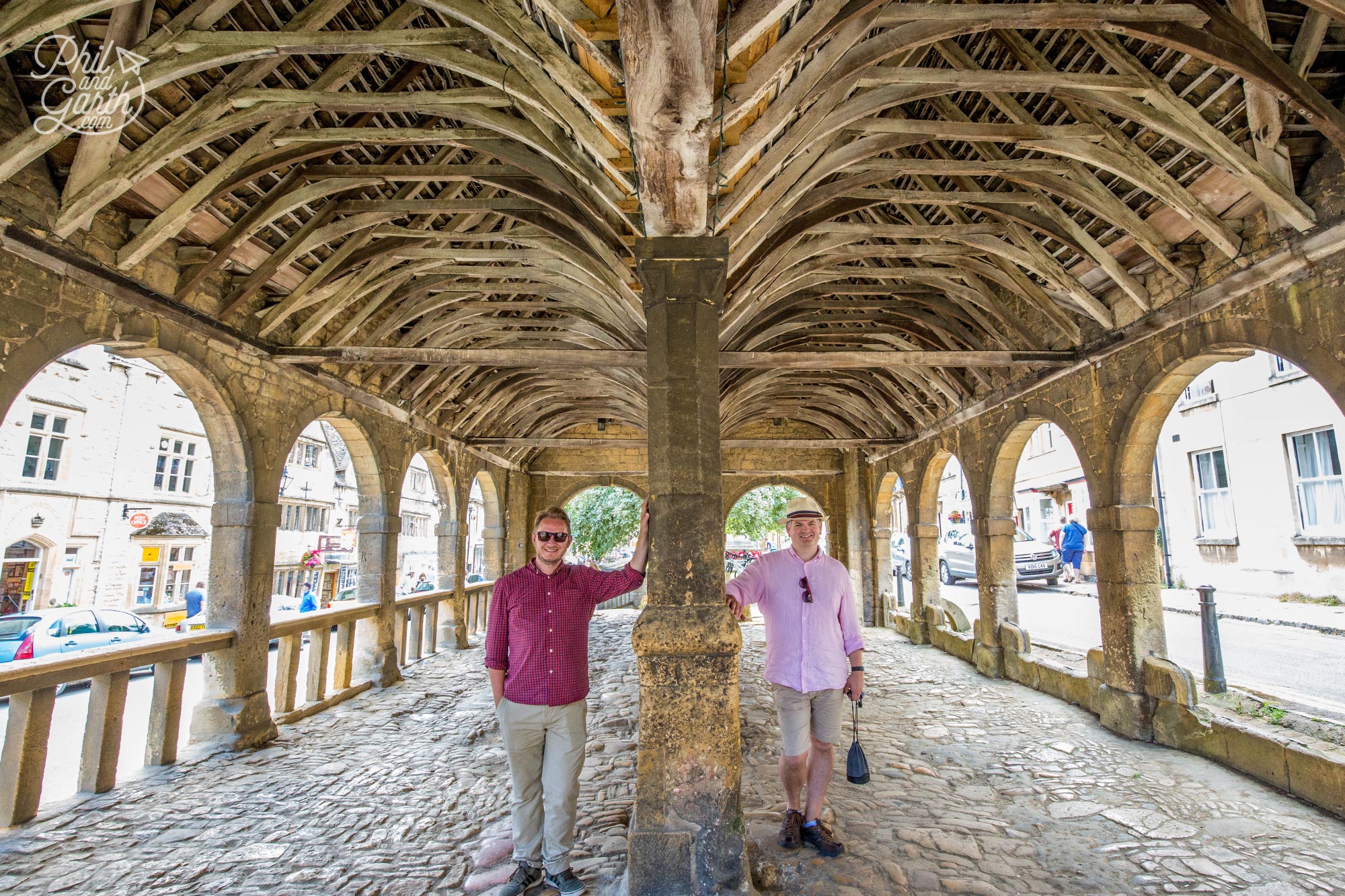
The 400 year old Chipping Campden market hall
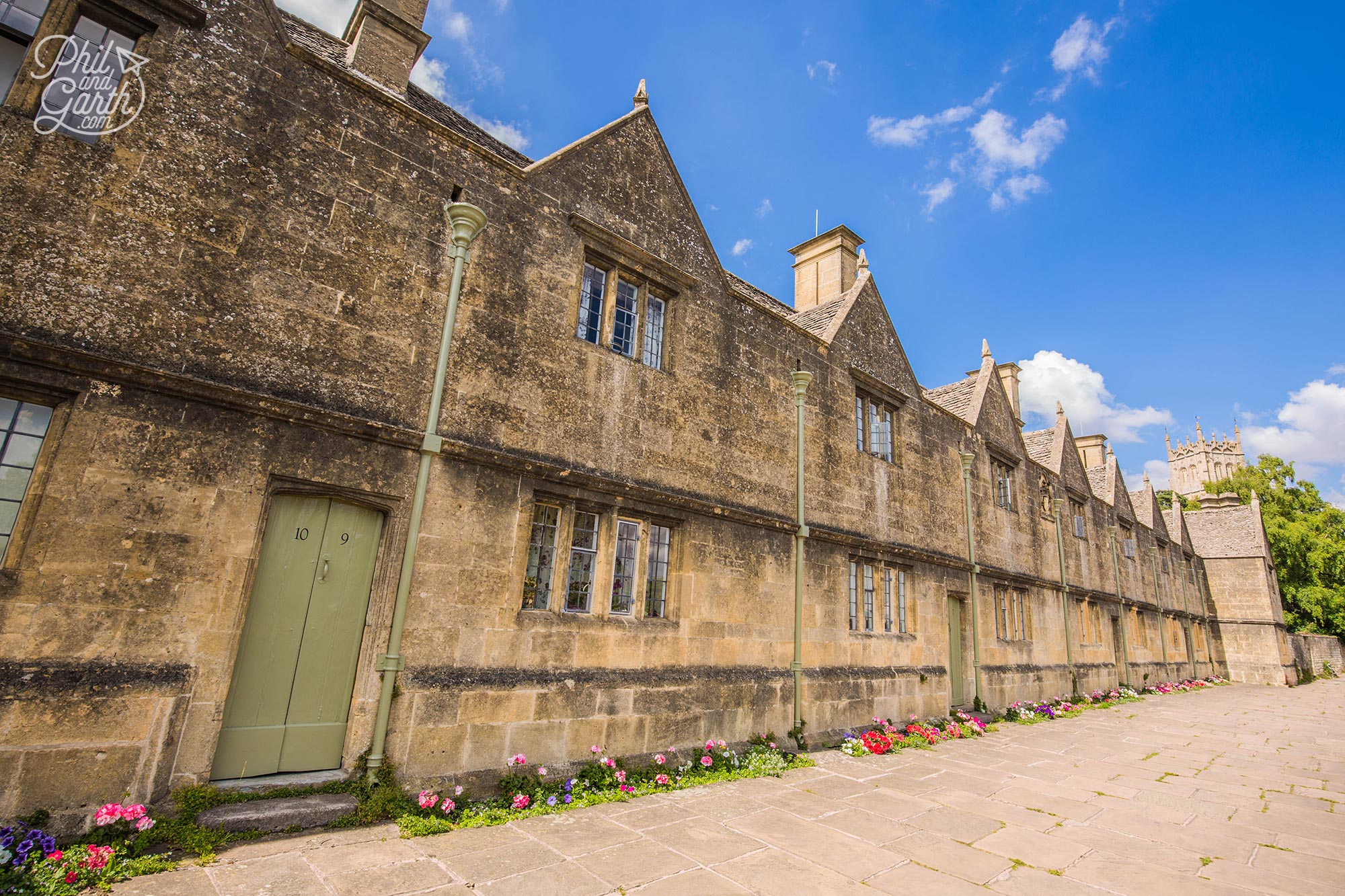
The Almshouses built by the parish for poor men and women
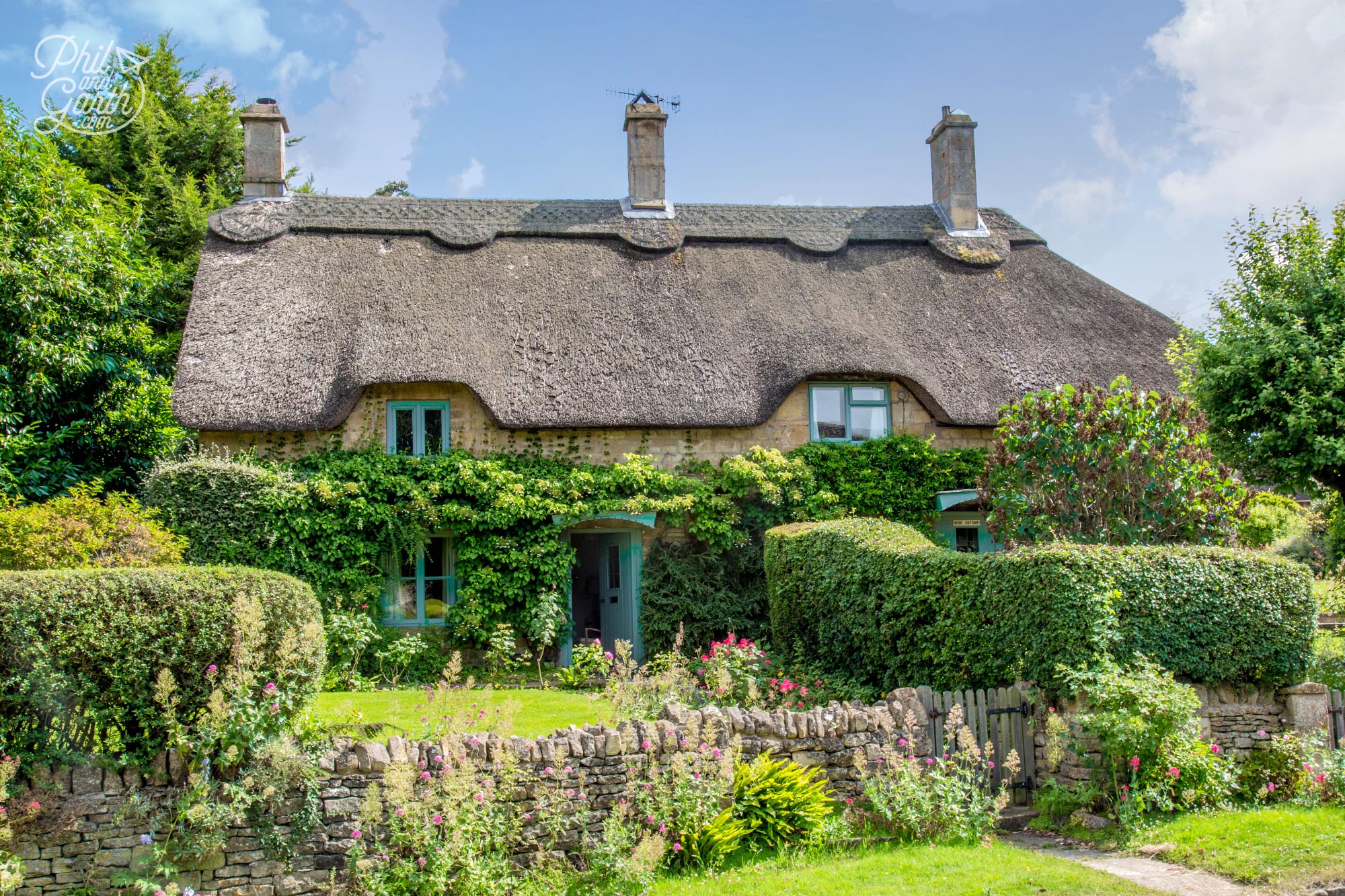
A couple of beautiful thatched cottages in Chipping Campden
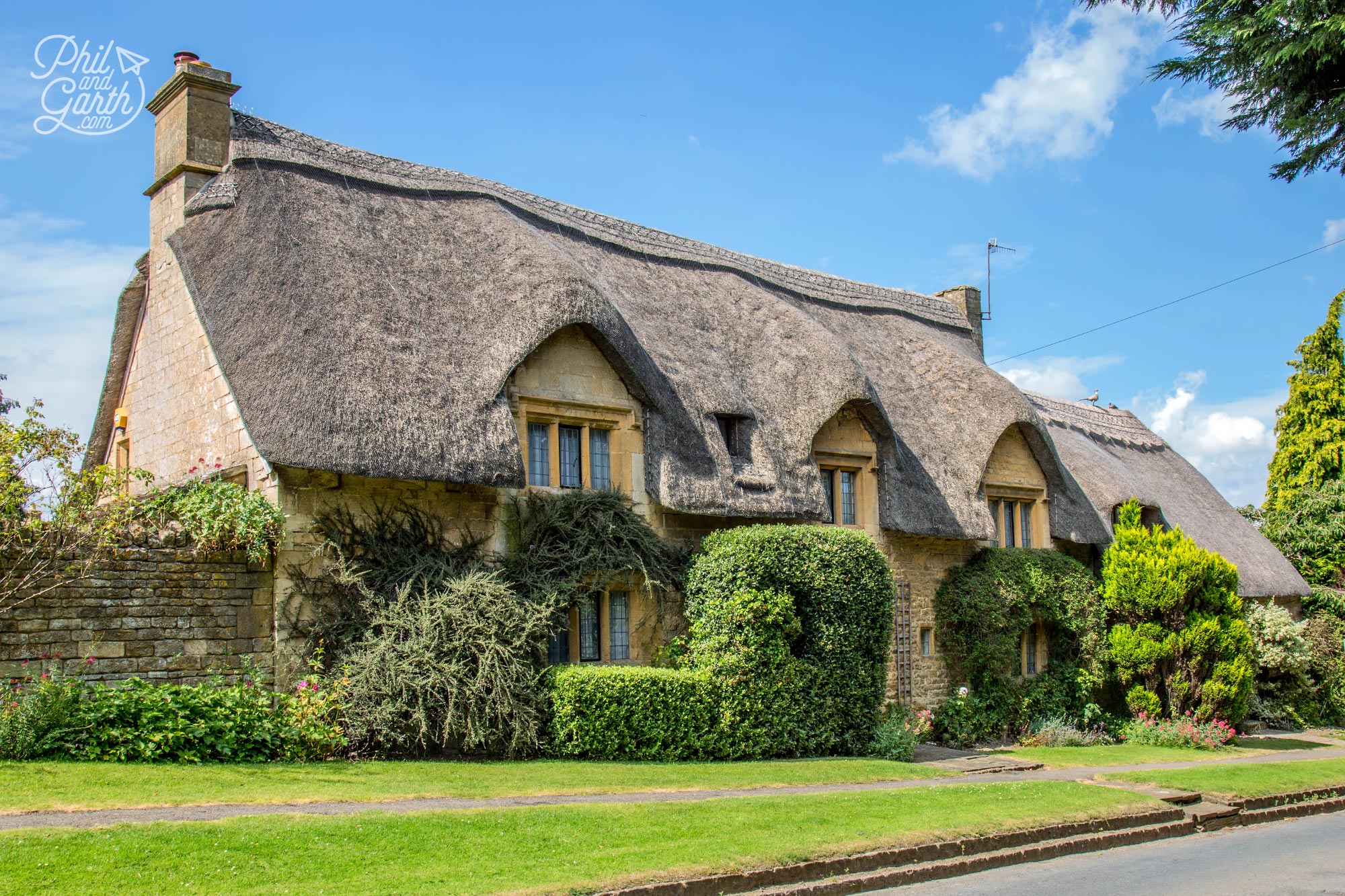
Another fine example of a Cotswold thatched cottage
We also had a nice walk around and found the town’s Almshouses and in the surrounding area, Garth photographed some exquisite thatched cottages.
Airplane Graveyard
On our way South from Stow on the A429 to visit Castle Combe we saw what looked like a Boeing 747 on the hill, as we got nearer we realised there was another, and another, and another – it was an airplane graveyard. This place is Cotswold Airport – a private airport which used to be an RAF base – Kemble. Garth’s favourite plane is the 747 (he won’t admit to being a plane nerd but he is) so we had to stop and have a look through the fence! There were dozens of these majestic looking 747s and other aircraft types, they must have been waiting to be decommissioned. An interesting sight in the middle of the English countryside, so don’t miss out if this floats your boat… or plane! Oh and it’s possible to book in advance tickets to visit an old British Airways 747, G-CIVB called ‘Negus’.

Boeing 747s at the airplane graveyard at Cotswolds Airport
Castle Combe
South of the Cotswolds lies the village of Castle Combe nestled in a small valley. We parked in the car park at the top of the hill, the village is about about 10 minutes walk away. Walking down the hill, (don’t forget you’ve then got to walk up hill on the at back – or one of you could walk up the steep hill to collect the car and pick the other up on the way back! But you wouldn’t do that would you Garth?!) The air was filled with the aroma of wild garlic from the woodland. The village was beautiful, absolutely charming with characterful homes. It appeared stuck in a timewarp as you sensed nothing much had changed since the 1400s, Garth felt it was like stepping back into a history book, while Phil felt like he was in Disneyland’s Ye Oldey Worldly Eng-land!
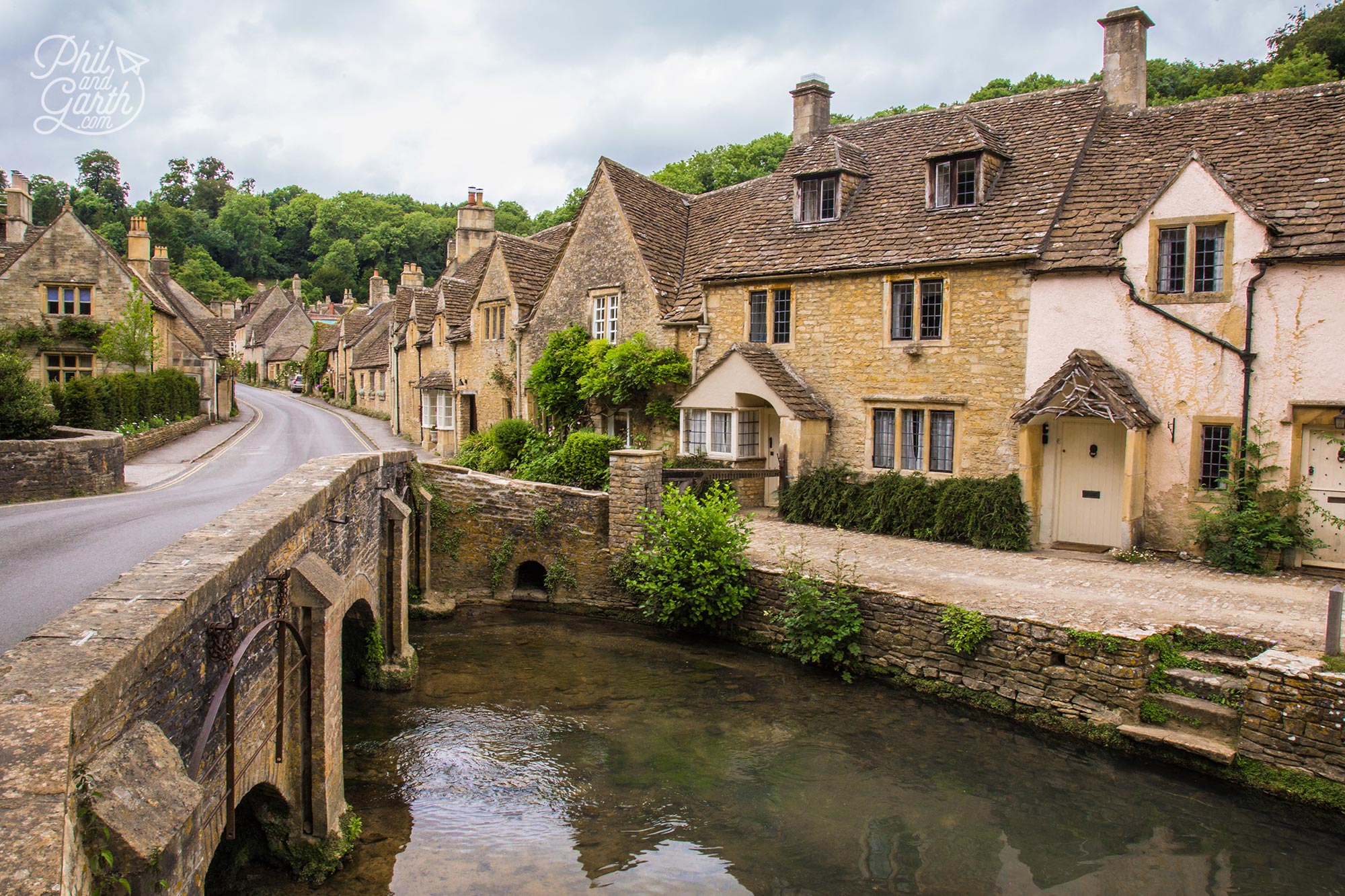
The classic photo spot with Town Bridge and the old weavers cottages
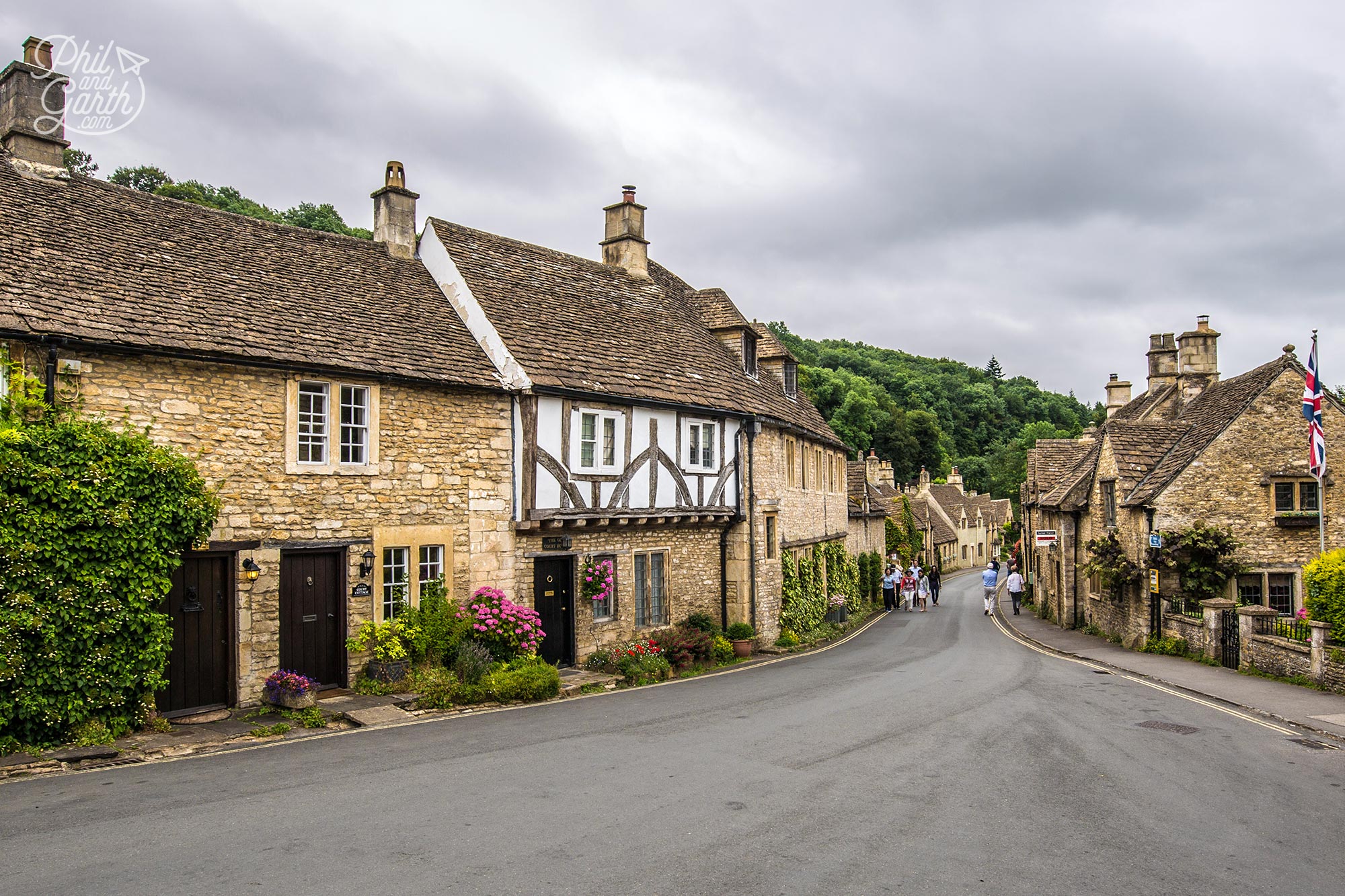
Picture postcard homes of Castle Combe
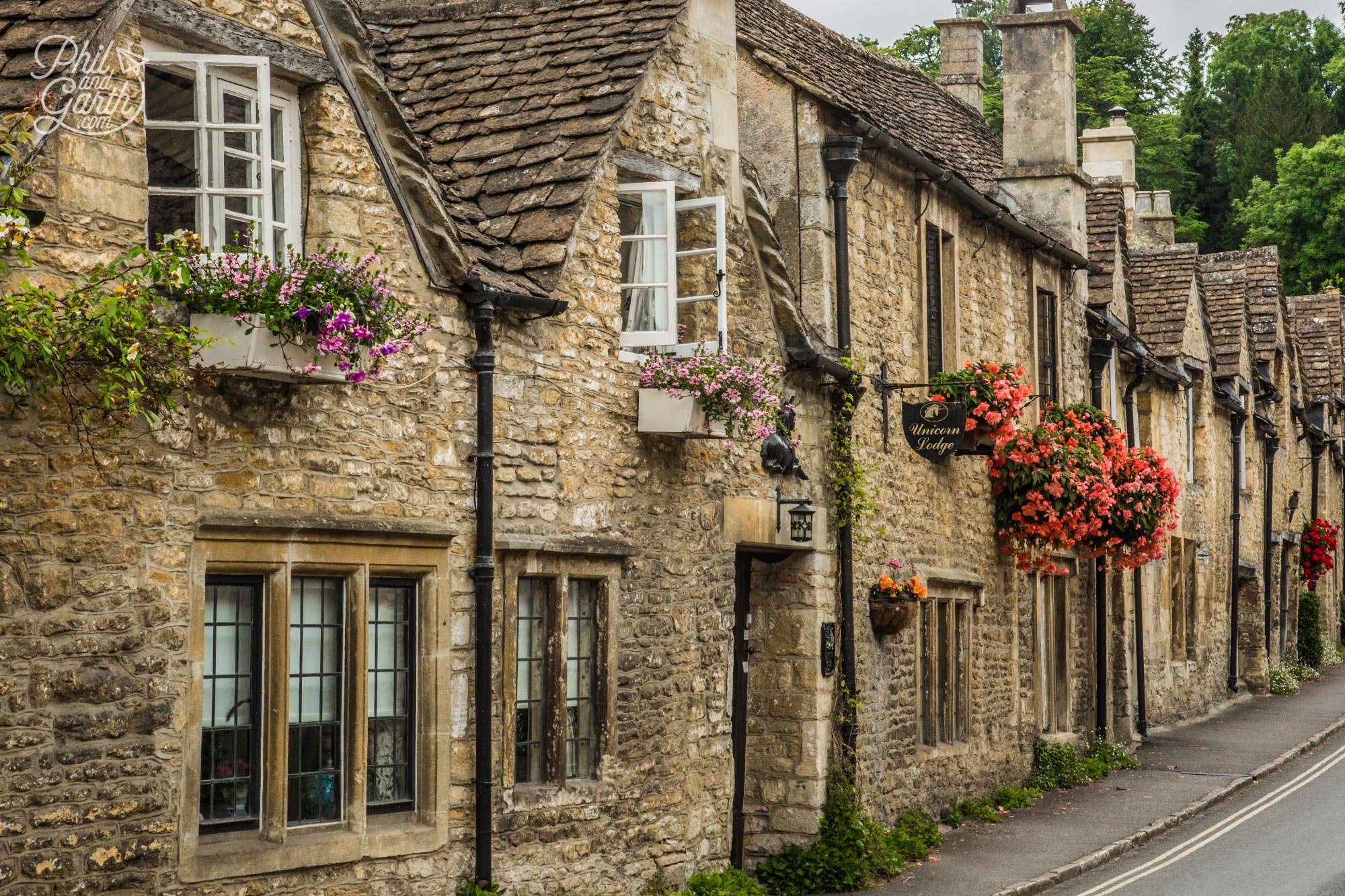
Lovely Begonia filled hanging baskets
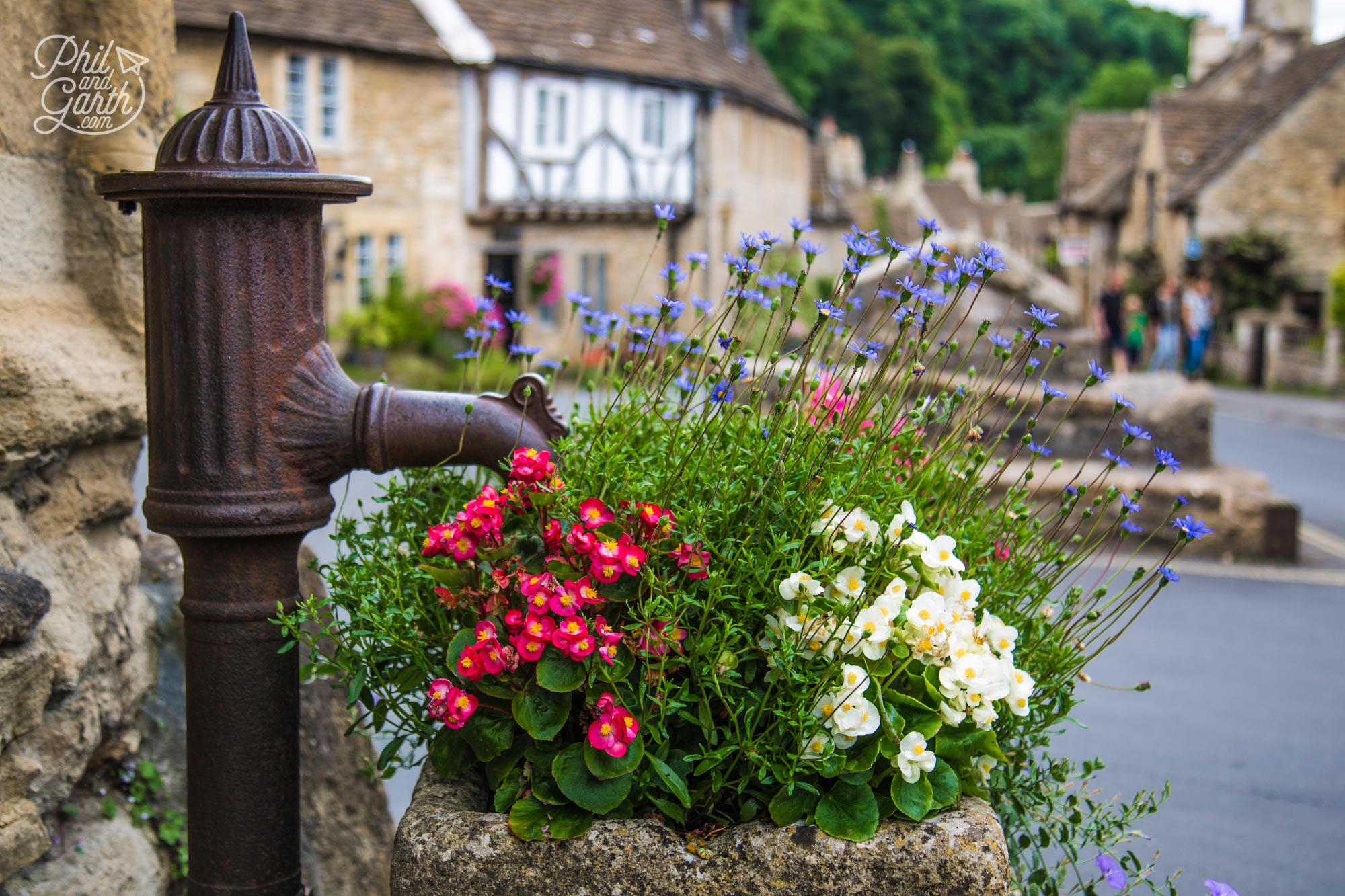
Castle Combe’s flower filled village water pump
There were lots more examples of that honey coloured Cotswold stone, we were told the colour of the stone deepens with age. The village was tiny, compared to the others we visited, so it didn’t take long to explore the homes, market square complete with old water pump and the church which is said to have one of the oldest working clocks in England. After a while we realised there were no Sky TV dishes or ariels and also no street lighting which is probably why we felt transported back in time.
If there’s one stereotypical Cotswold scene you’ll have seen on TV and in film then it’s most likely to be Castle Combe. Film director Stephen Spielberg used the village as a location for War Horse, other film and TV credits include Wolfman, Stardust, Dr Dolittle and Poirot. We thought to hire out the village all you have to do is cover up the double yellow lines, and the village is good to go!
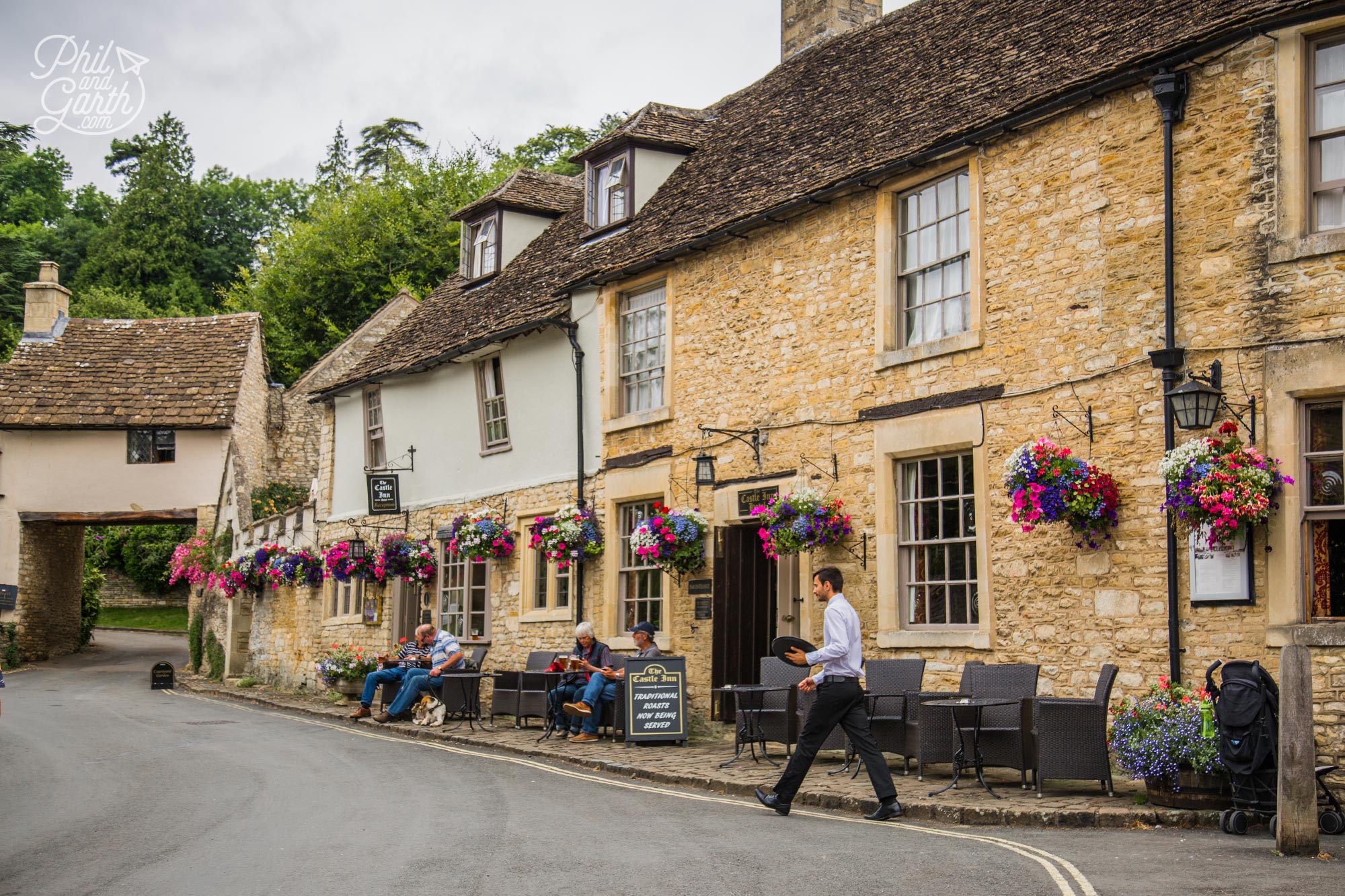
The Castle Inn, Castle Combe
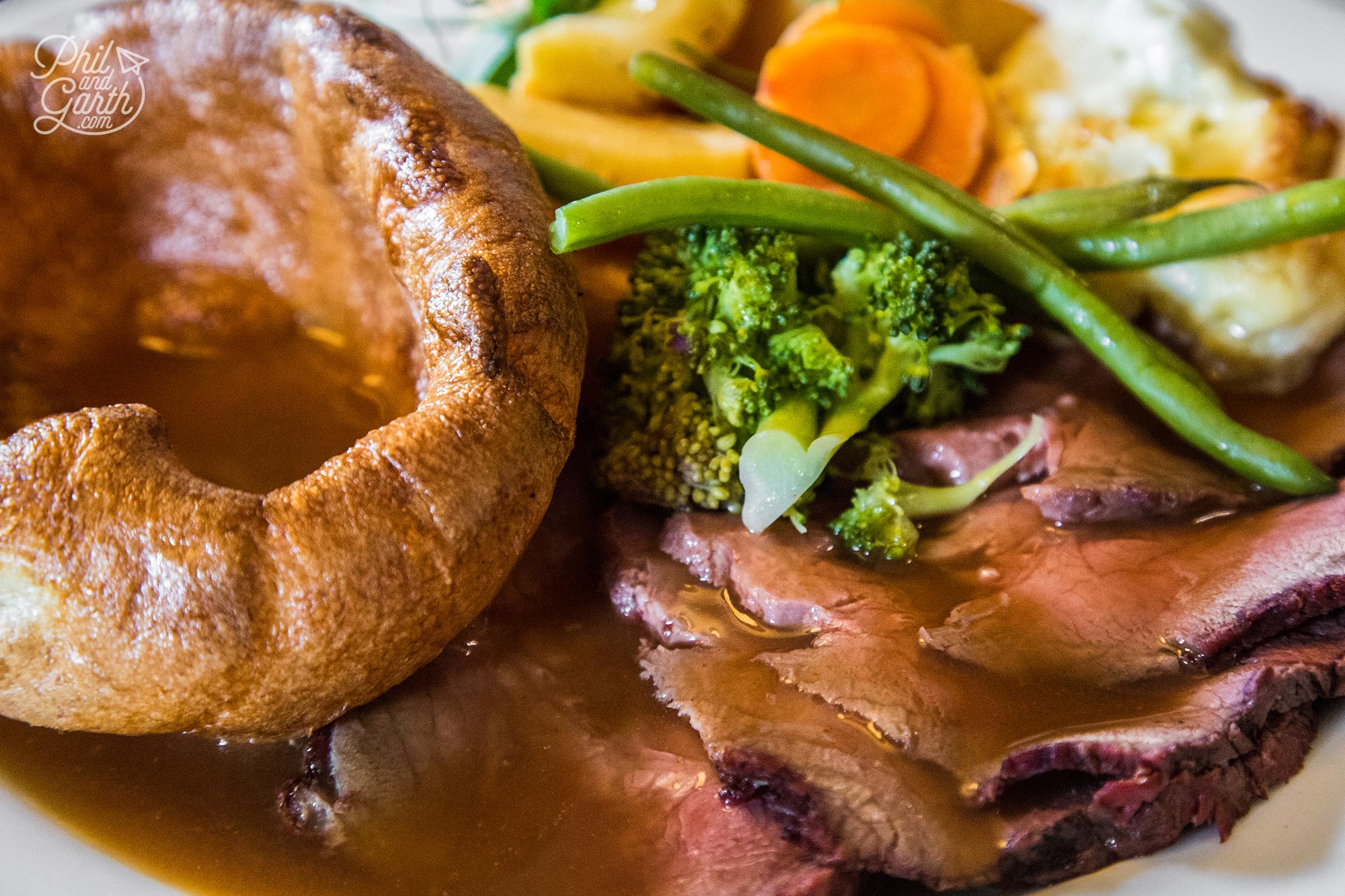
Traditional roast dinner at The Castle Inn
Time for our favourite weekend treat – a traditional Sunday roast at The Castle Inn. It was delicious! and even better in the flesh than the images on their website. Alternatively you could have a cream tea at The Old Rectory Tea Room and you can get home made cakes opposite and pay with an honesty box – how quaint!
Before we knew it our 3 days were up, and it was time to get back on the road and head home. There’s no doubt the Cotswolds offers some of the best sightseeing in England. With beautiful unspoilt countryside and enchanting villages hidden away in valleys, what’s not to love?
Cotswolds Facts, Information & Advice
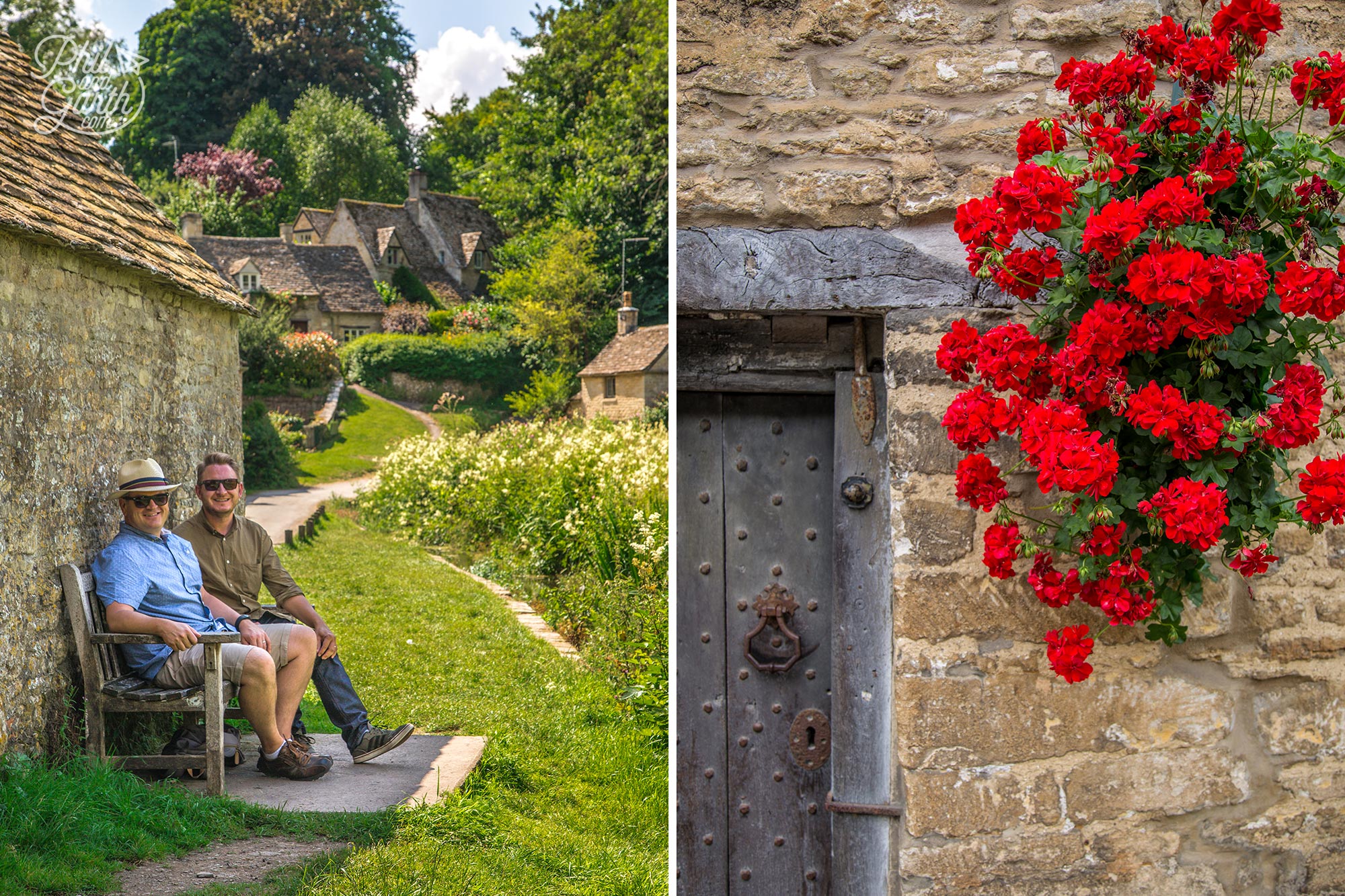
Phil and Garth at Bibury
Phil and Garth’s Top 5 Cotswolds Travel Tips
- Tip #1: Cotswolds is a big area with lots of villages, so make a rough plan on places to visit before you go.
- Tip #2: Small and quieter villages are only a few miles apart. You can leisurely do 4 or 5 places in a day.
- Tip #3: Into hiking? The Cotswolds Way is a 102 mile trail that runs the entire length from North to South.
- Tip #4: Spring and Autumn are the most popular times for visitors, because it’s drier.
- Tip #5: Got more time? Bath, Oxford are really close by and definitely worth seeing.
Cotswolds Fast Facts
- Airport Code: BHX – Birmingham Airport is the nearest airport, 57 miles away.
- Time: GMT +0
- Currency: Pound Sterling (symbol: £)
- Language: English.
- Population: 139,000.
- In An Emergency – Call 999.
- Electricity: Plug Type G. Voltage is 240V / 50Hz.
- Best Time To Visit The Cotswolds: Summer and autumn are the best time.
- Worst Time To Visit The Cotswolds: November to March is cold and wet.
- Famous For: Countryside, picturesque villages, market towns, thatched cottages and cottage gardens.
- History: The first and final battles of the English Civil Wars were fought in the Cotswolds in the 1600s.
- 5 Must See: Stow-on-the-Wold, Bibury, Bourton-on-the-Water, The Slaughters and Castle Combe.
- Local Food: Tewkesbury mustard, Bibury trout & Stinking Bishop cheese.
- Getting Around: You’ll need a car to drive between the villages.
- Trivia: Coopers Hill holds an annual cheese rolling competition. It involves rolling a round of Gloucester cheese down a hill. The person who reaches the cheese first gets to keep it!
- TV & Film: Bridget Jones’s Diary (2001) was filmed in Snowshill. Scenes from Harry Potter were filmed in nearby Gloucester Cathedral.
- Best Photo Spot: Castle Combe.
- Hidden Gem: Snowshill village.
- Souvenir: Cotswolds Lavender Soap.
How We Did It
- We paid for 2 nights at The Stag Lodge (see above)
- We visited the Cotswolds at the end of July.






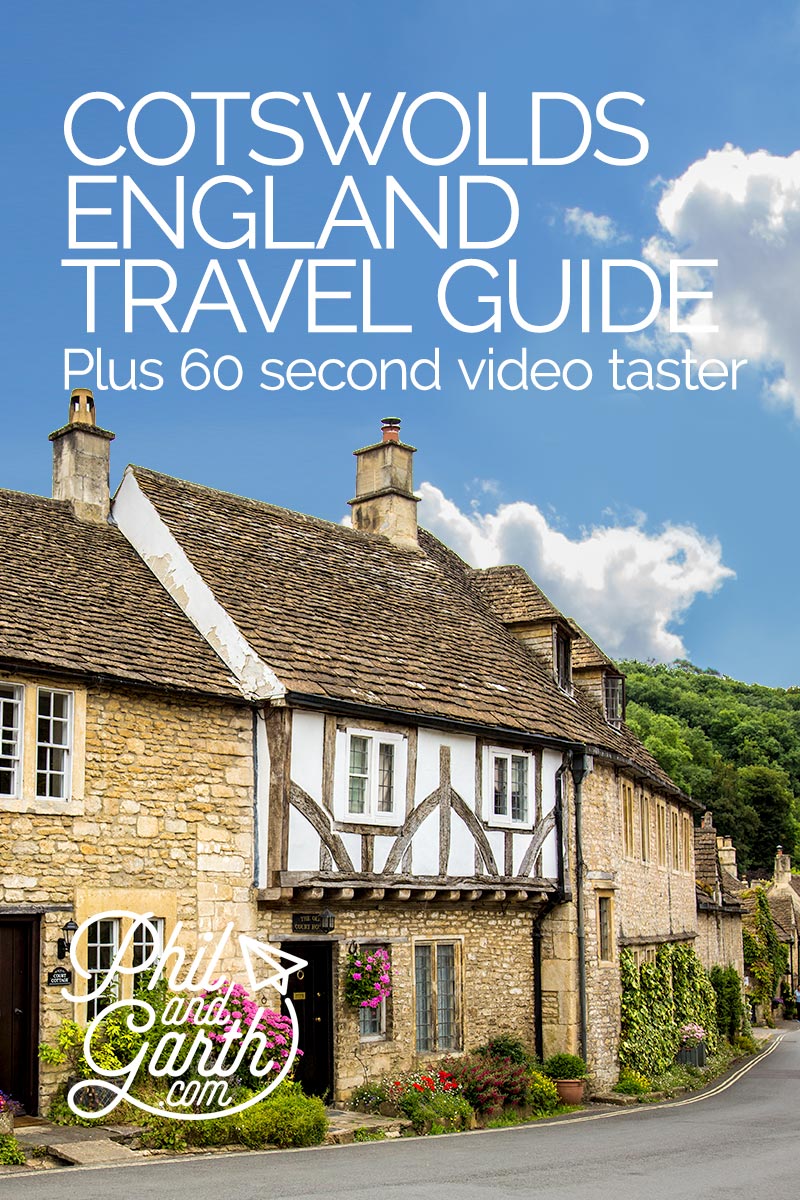
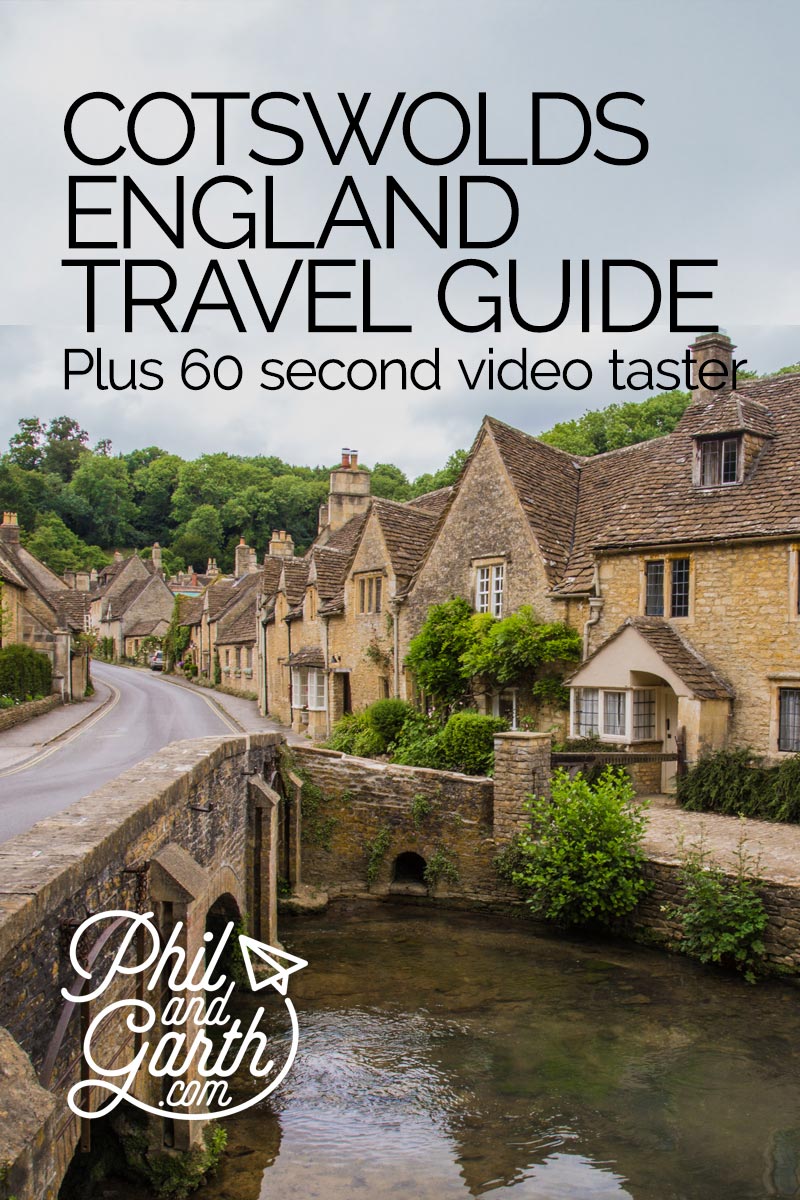
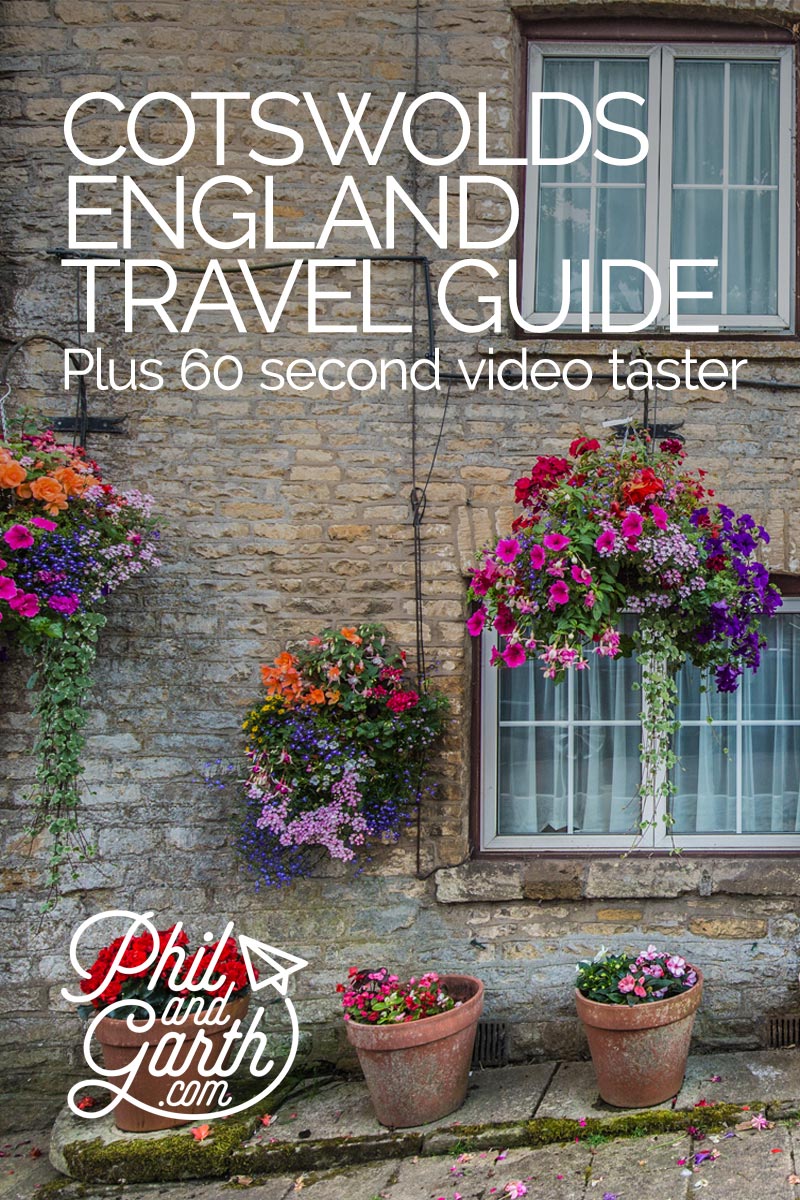
16 comments
Love what you guys are doing…keep us in mind next time you’re here in the UK: aroundandaboutbath.com. Would be great to open up a convo about collaborating with you. We’re all about showing people the hidden gems of the Cotswolds and beyond. Keep up the good work.
Hi Guys
Loved reading all about the Cotswold we are coming from Australia in December and wanted to work out some of the quaint little villages to visit, at that time, making our way to Bath do you have maybe a few more places you can tell us about.
Thanks Sharlene and Sam
Heys guys other than the villages we’ve covered in the post, I’m not that familiar with other villages on route to Bath. However you might want to consider visiting historic Oxford which is very close to the Cotswolds before you head to Bath?
Wow so beautiful! and great photography! Can you please tell me what dates you took these? I am planning on beginning the UK early July & am hoping the flowers will be blooming like this 🙂
Hi Jess, July should be perfect for all the flowers, FYI we arrived in the Cotswolds on the 20th July.